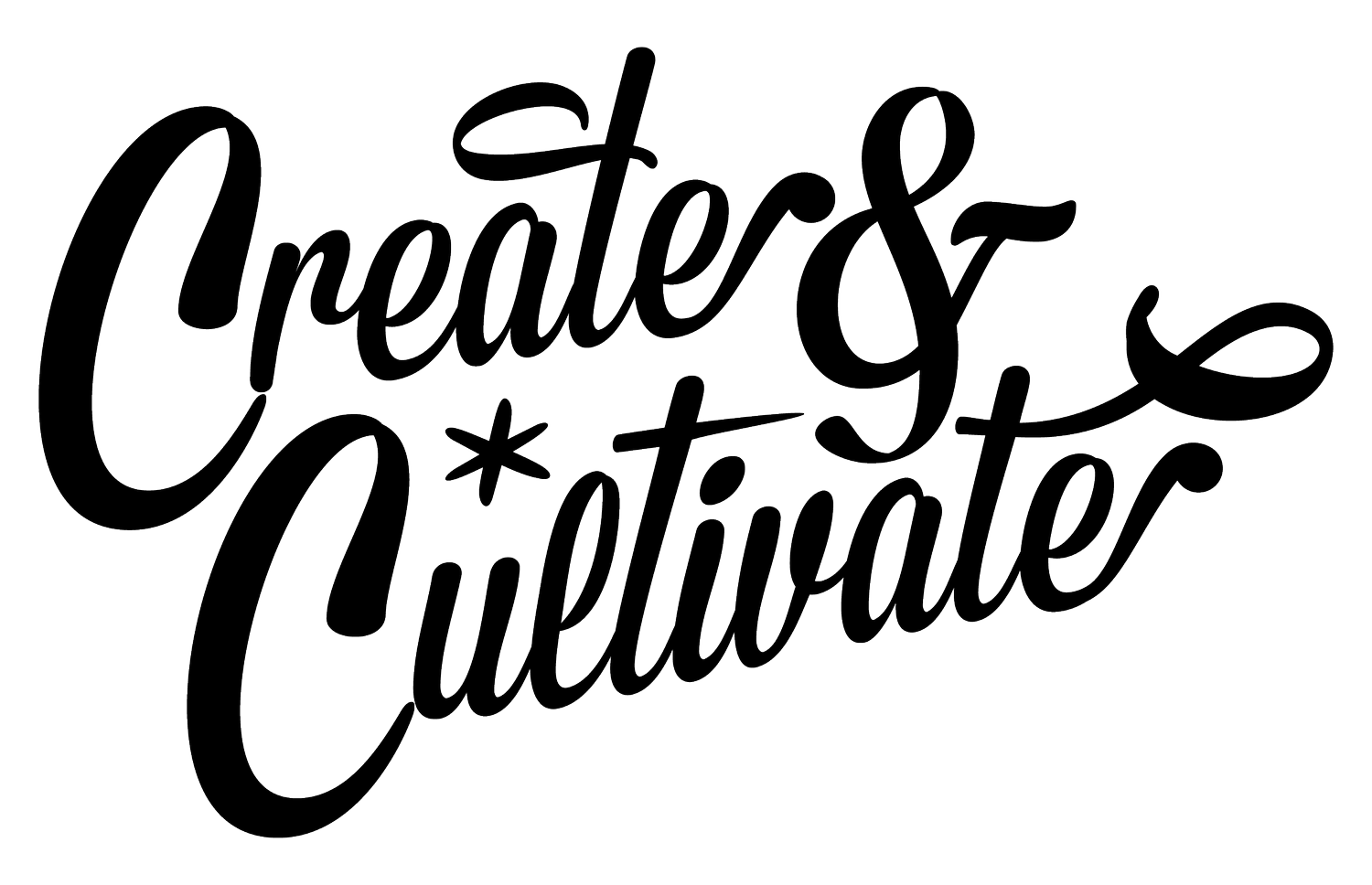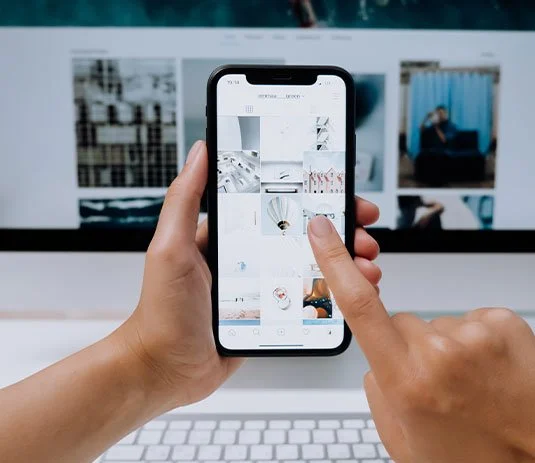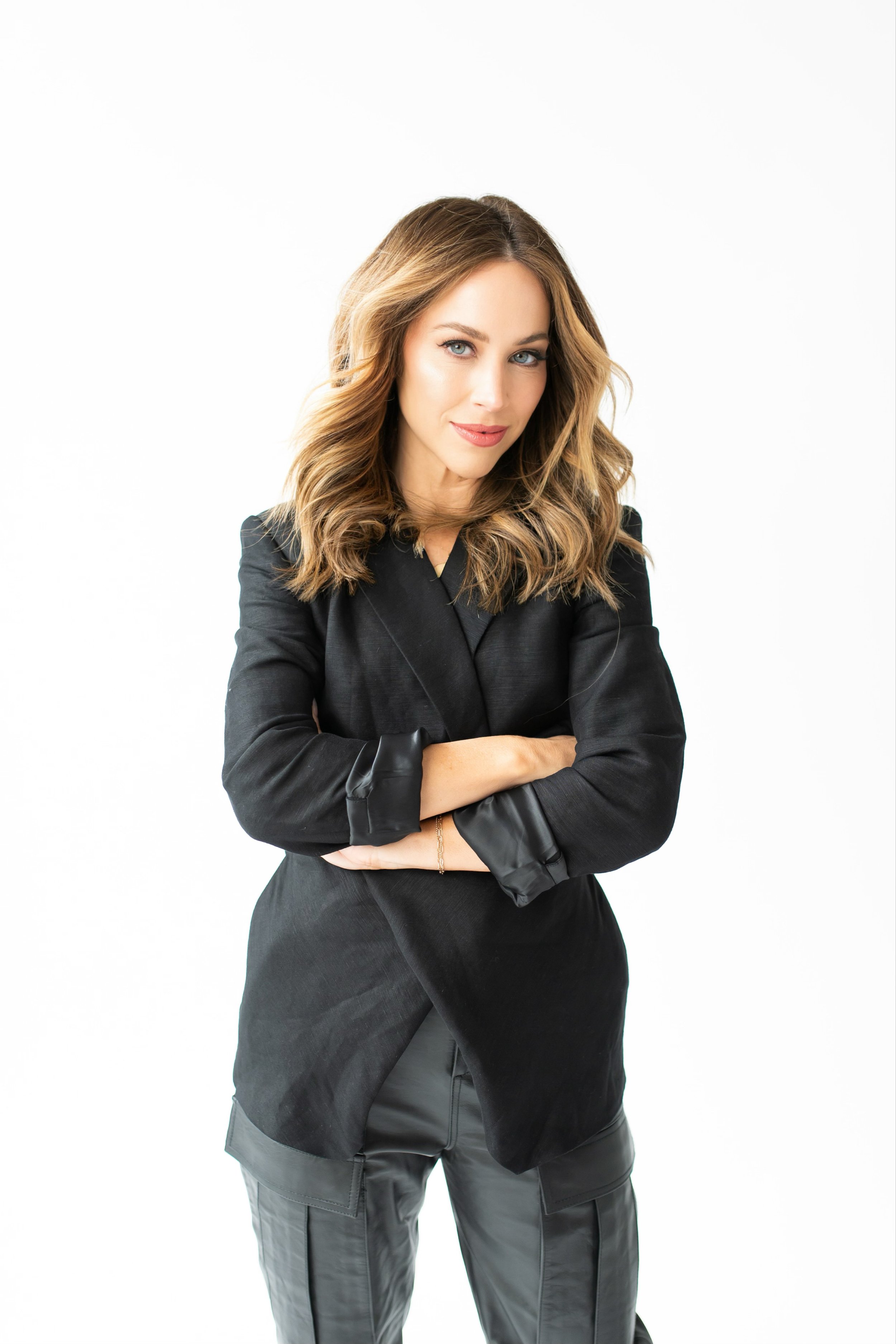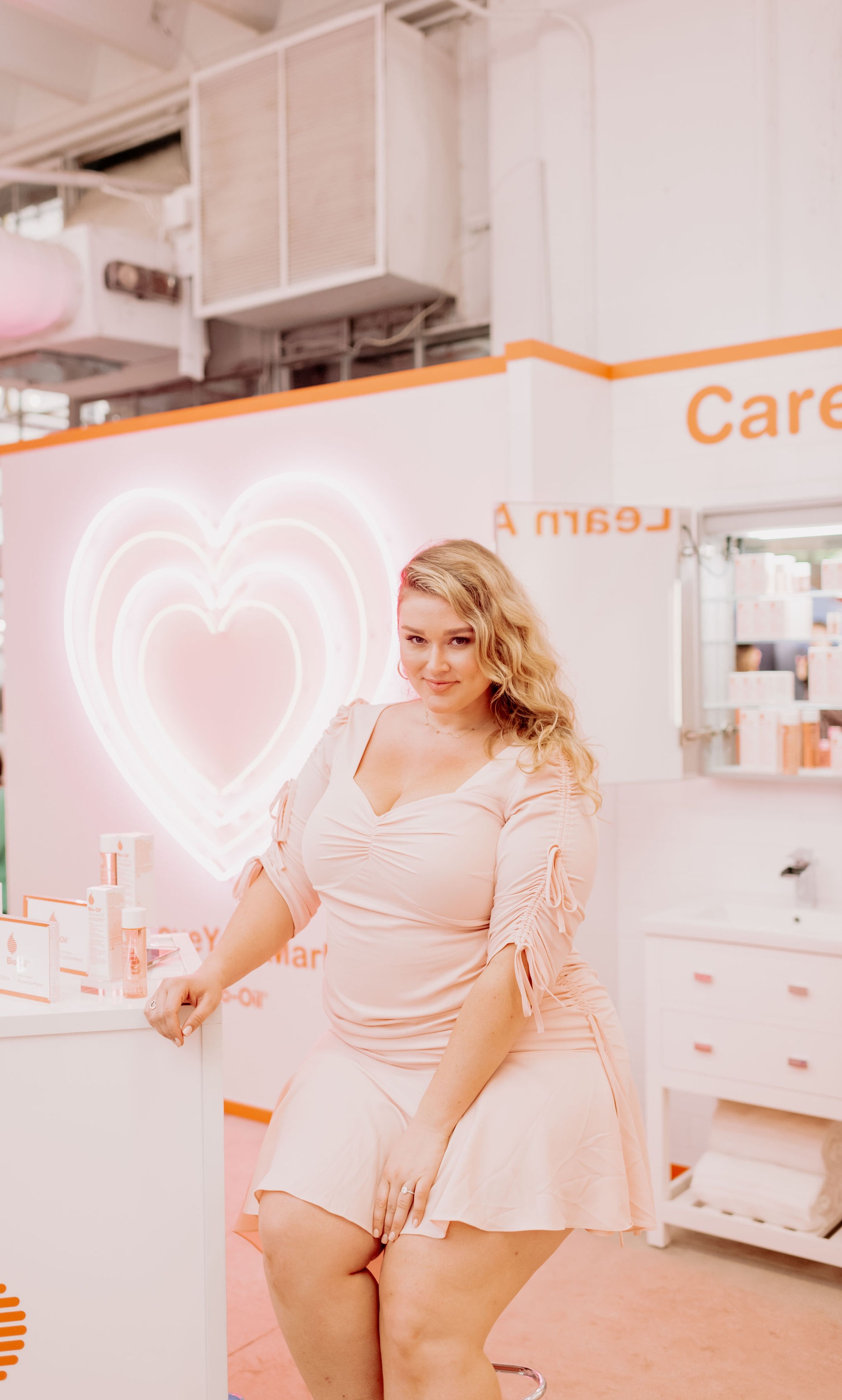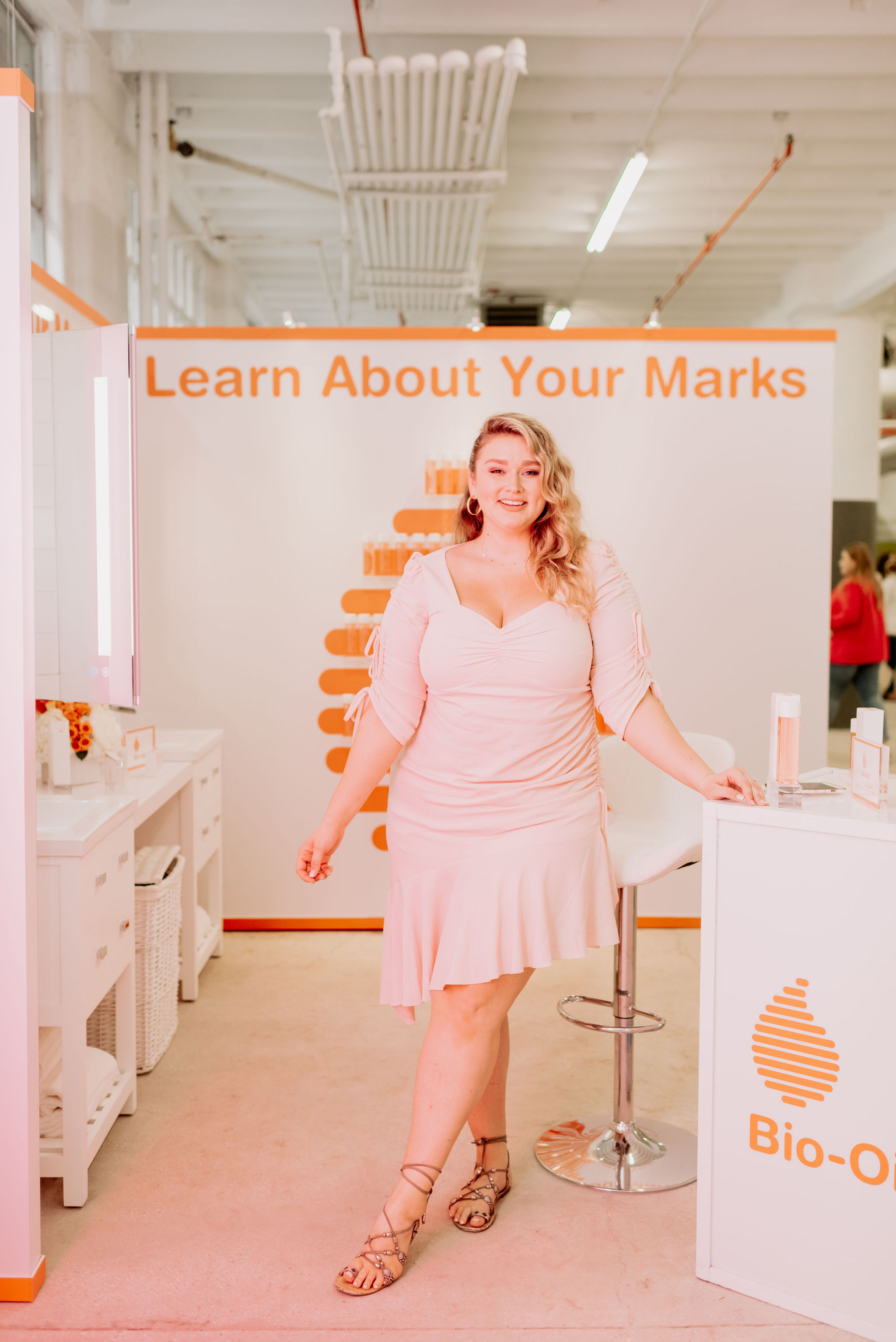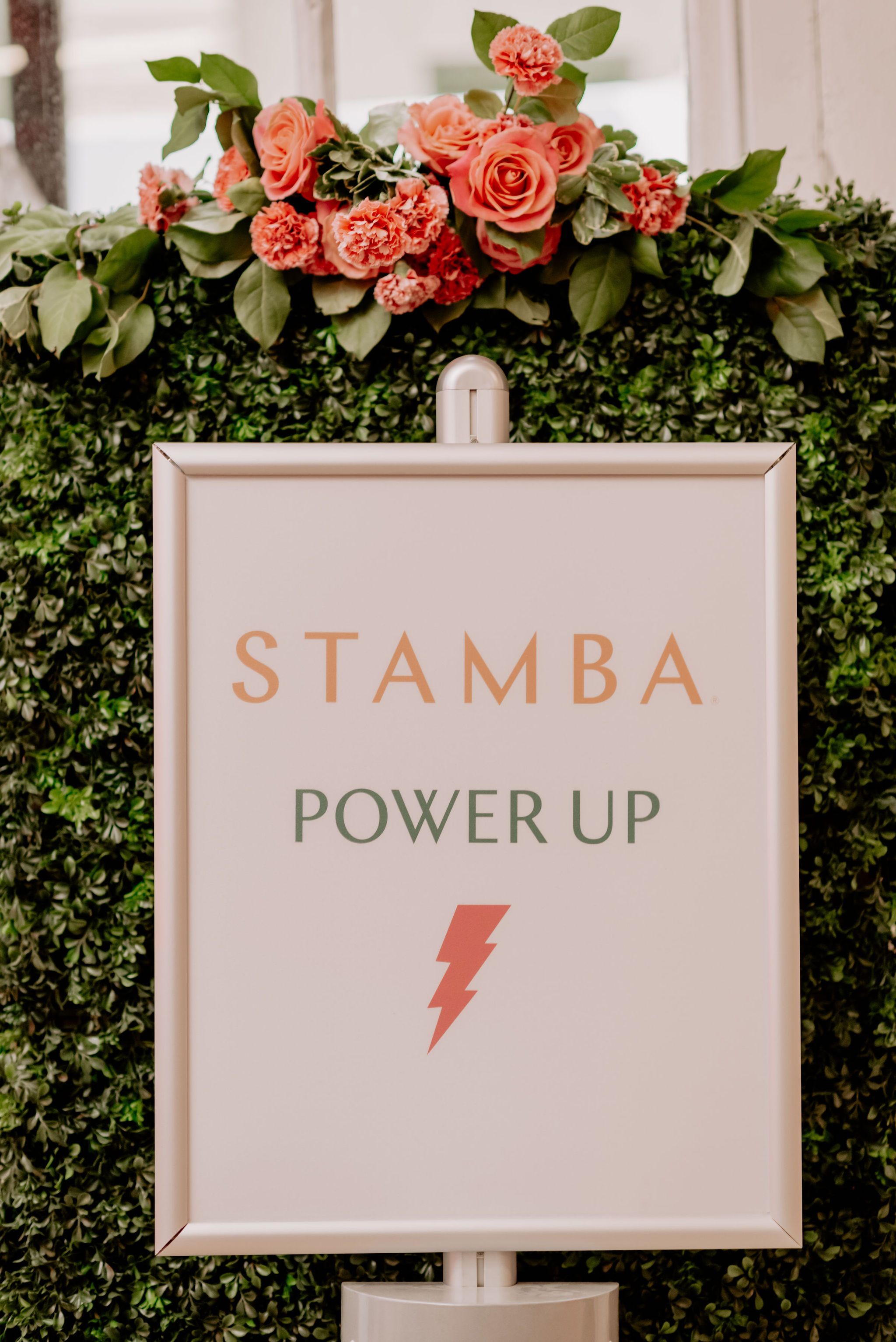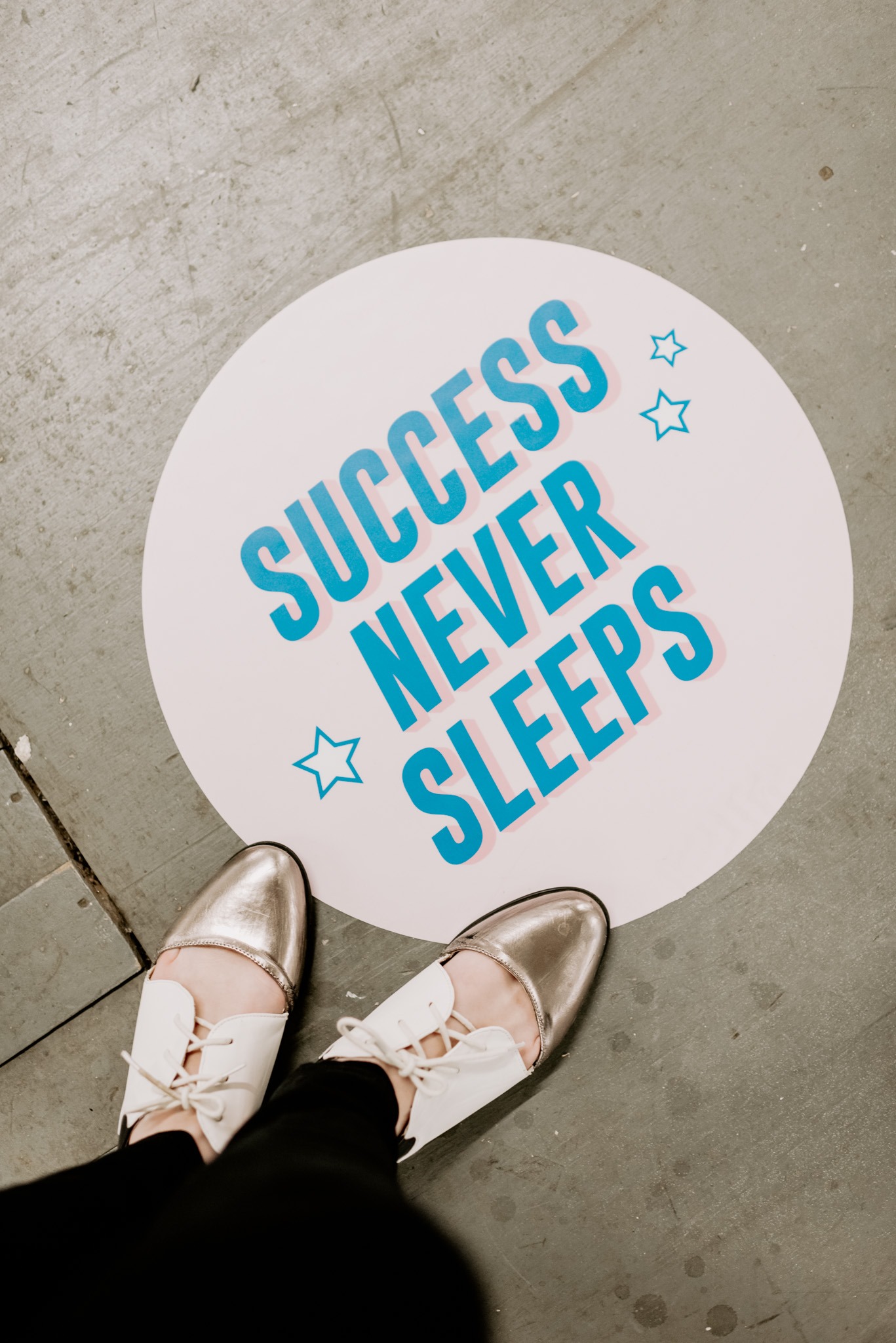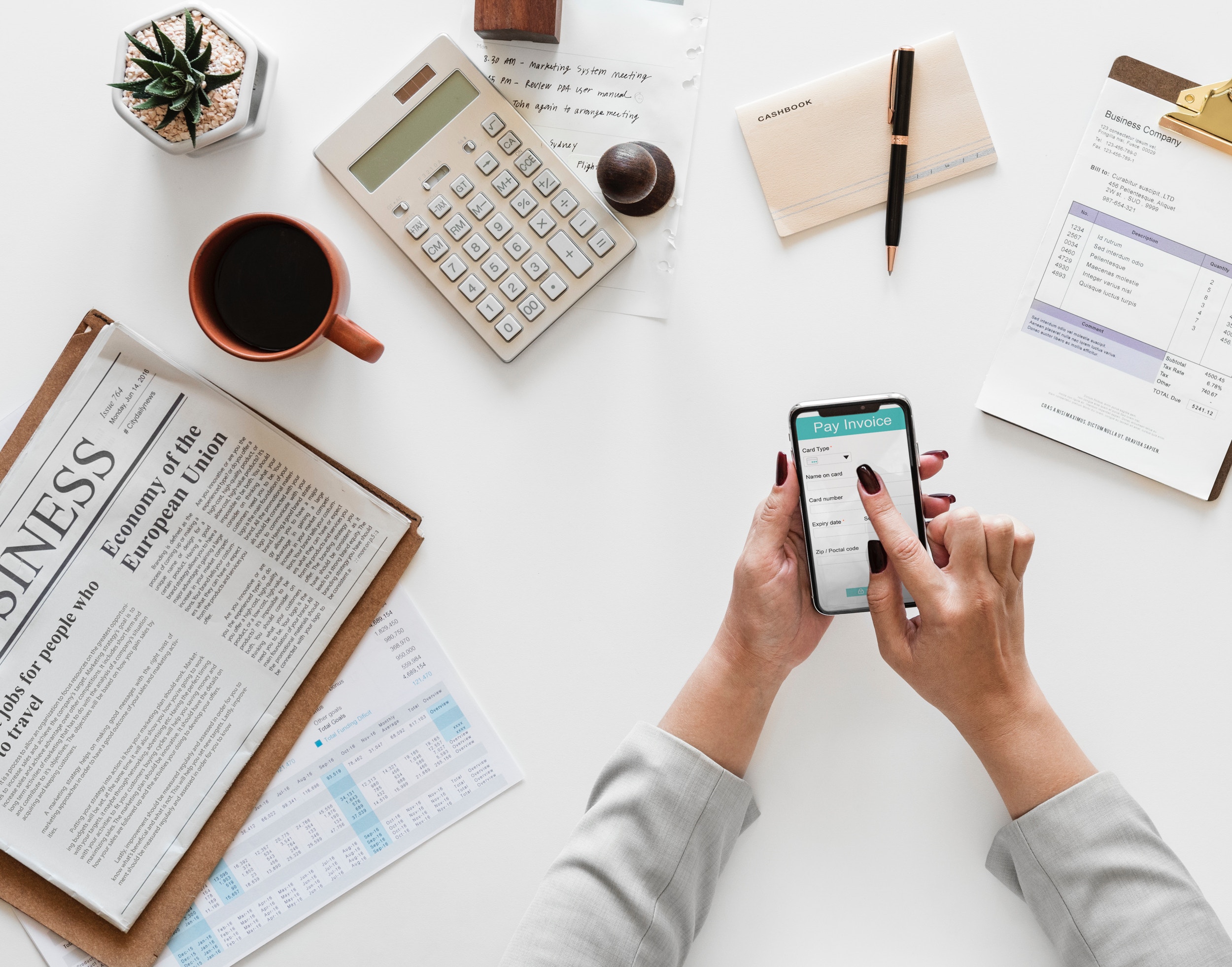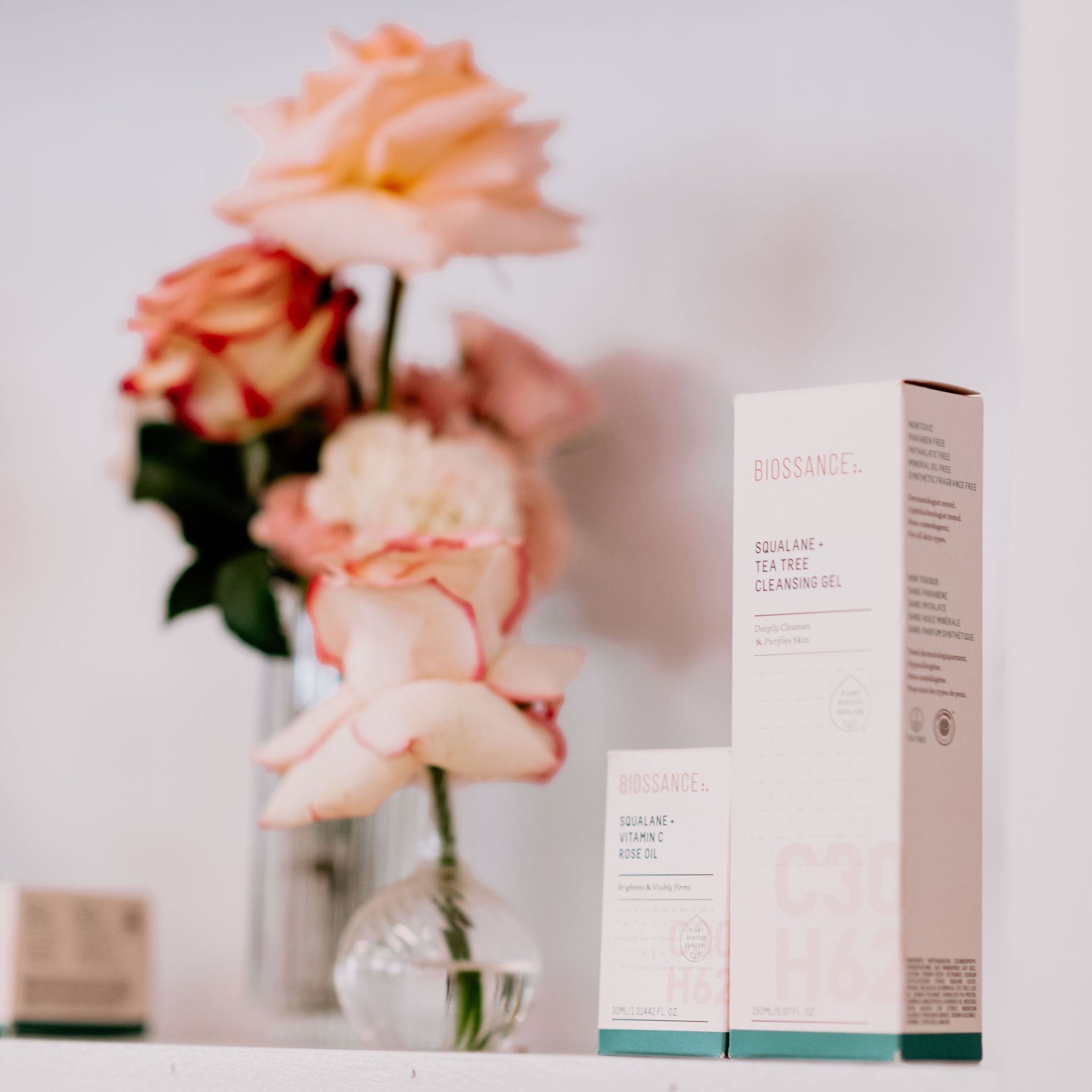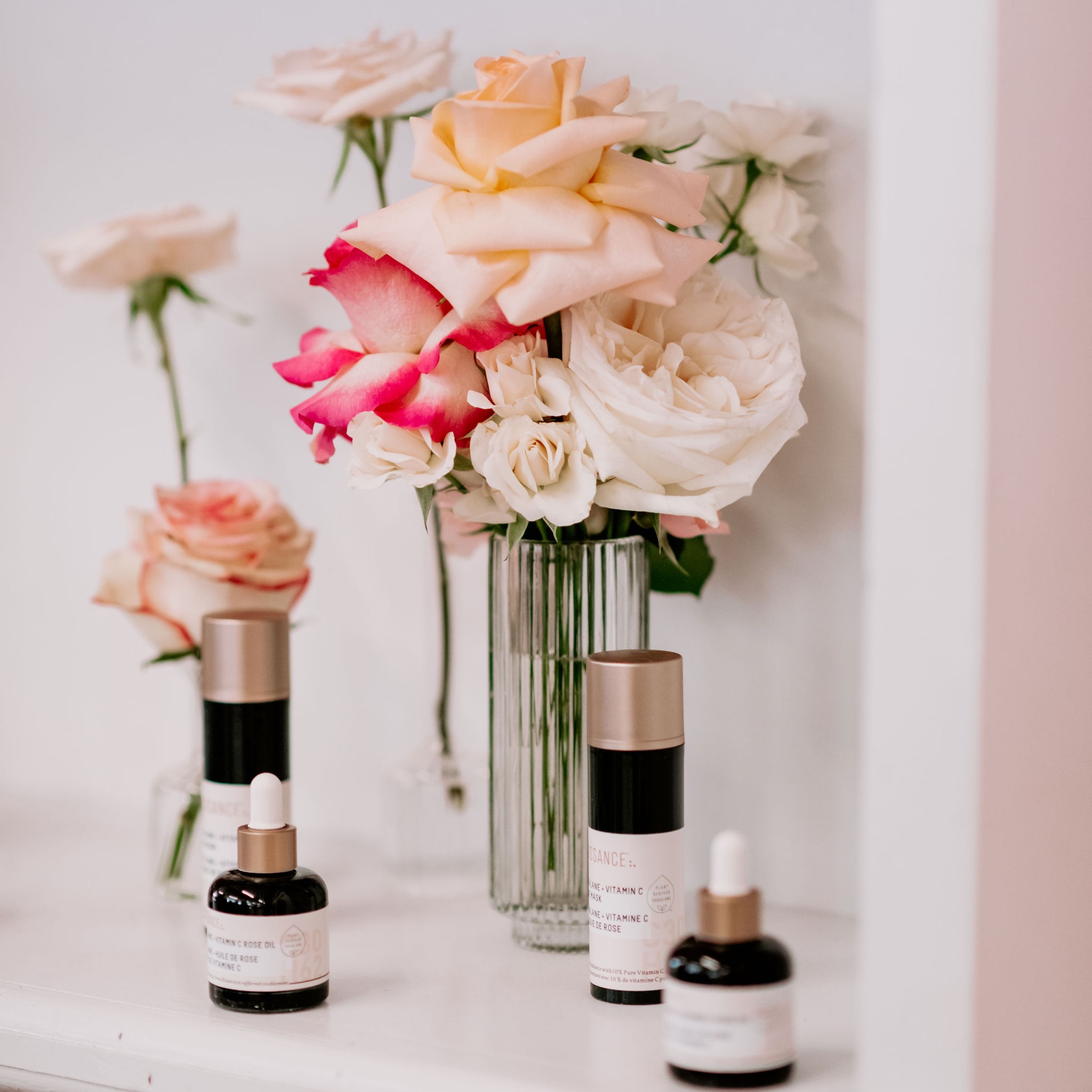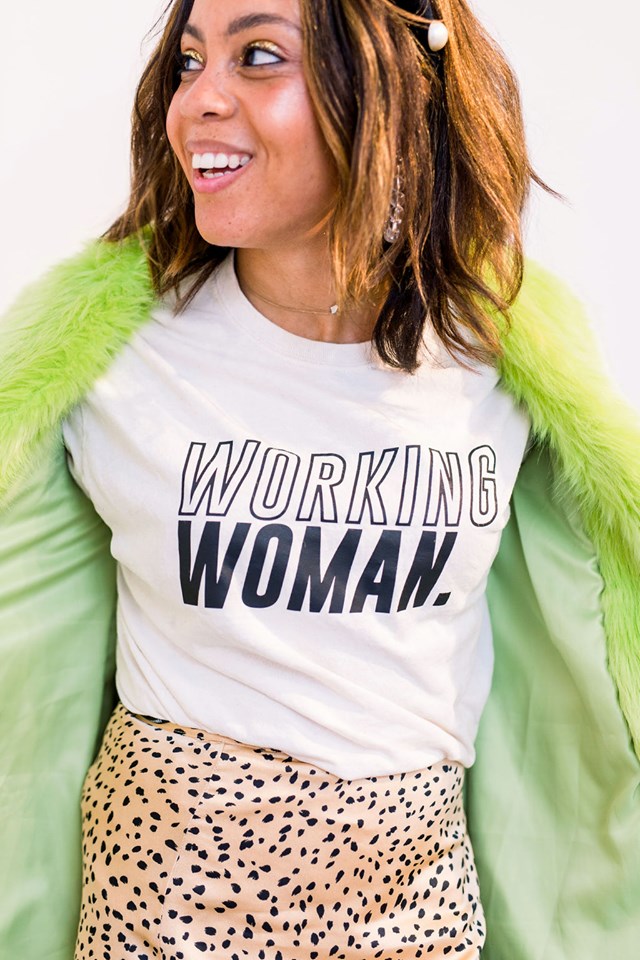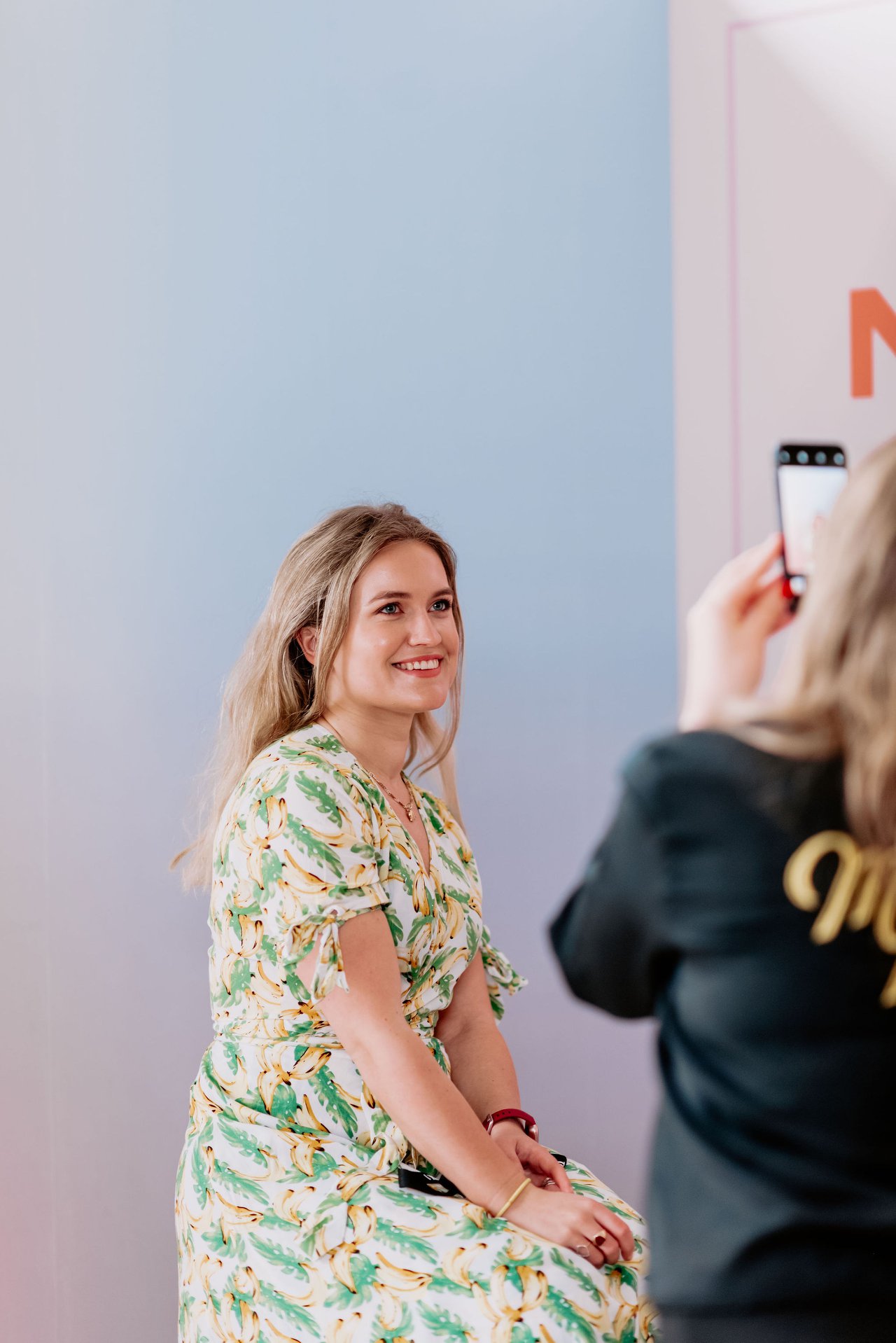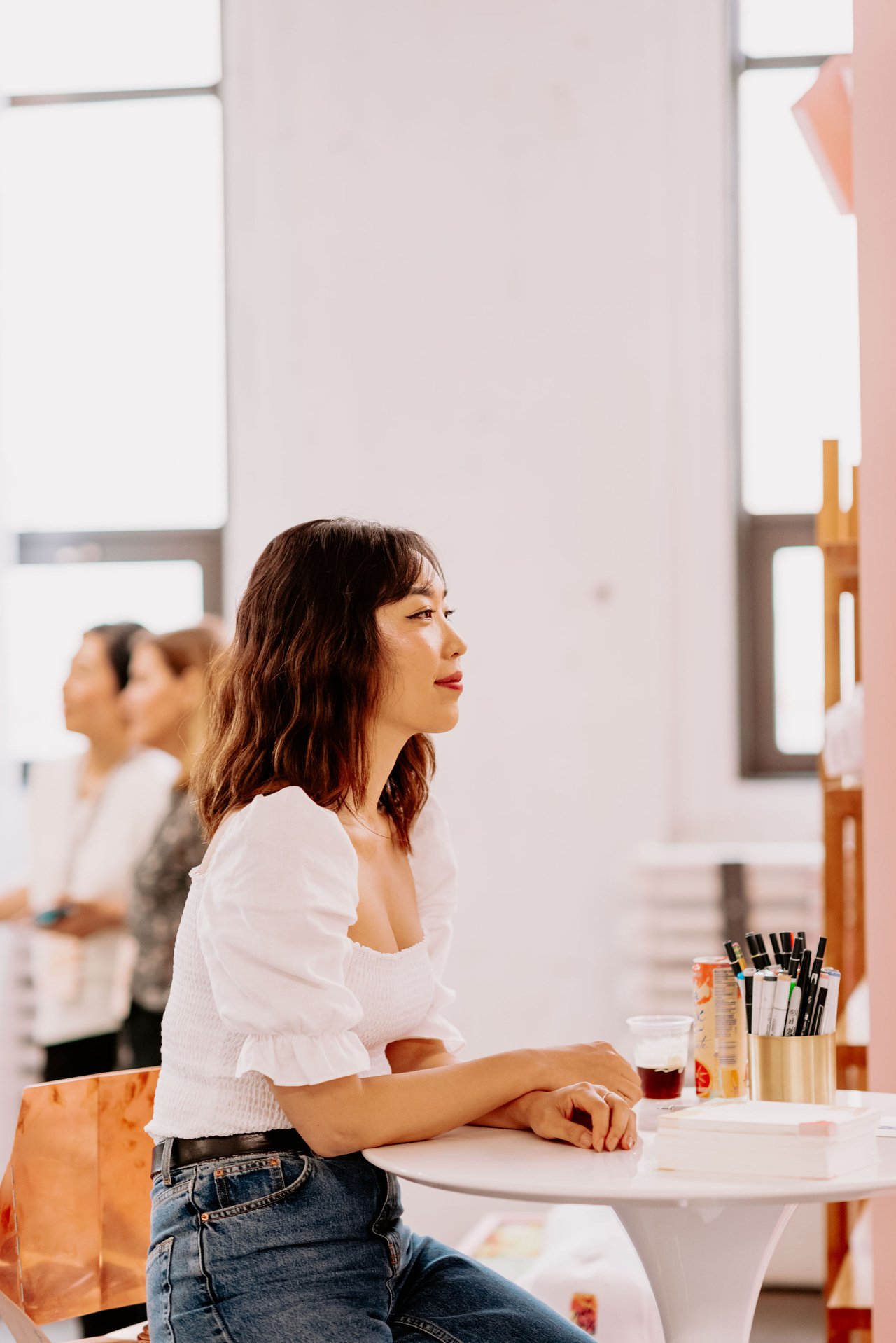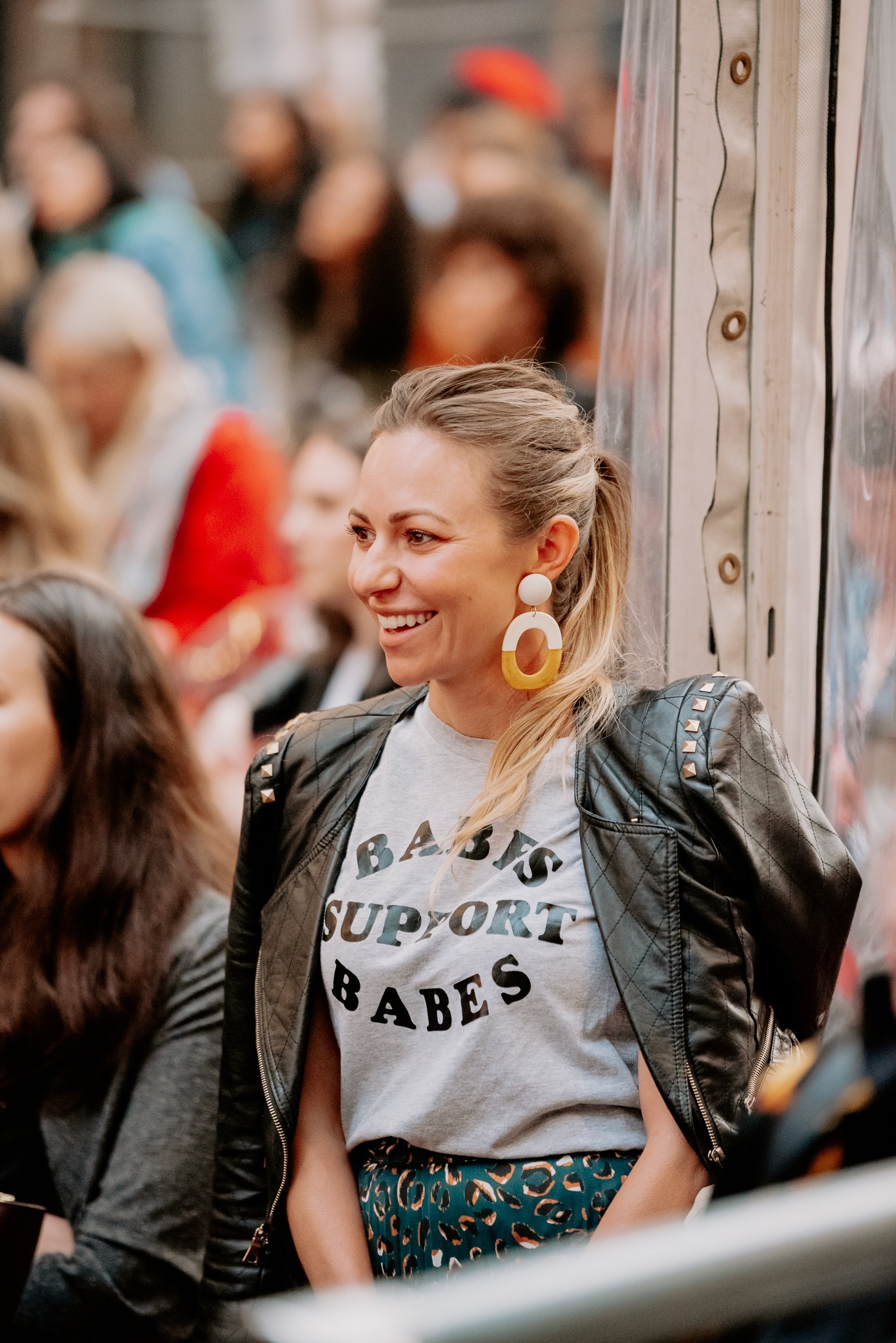Our C+C Community Can’t Get Enough Of This Game Changing Haircare Line—Here’s Why
Changing lives, one curl at a time.
We get it. Facing a situation that seems to have no solution can be frustrating. Just like when something doesn’t go your way—feeling a lack of solution and control is not ideal. But with a little bit of knowledge-dropping and female support, we can really take on anything. The female community we pride ourselves on being a part of is all about support, confidence, and education. And hair care company, DevaCurl, identifies with the same philosophies.
In 1994, DevaCurl provided the hair care industry with long-awaited solutions for curls. Women with seemingly stubborn, curly hair, were finally able to embrace their beautiful locks with these curl-enhancing products. We love strong, confident women who embrace their natural selves and brands that do too.
But we aren’t the only fans of DevaCurl—our C&C community can’t seem to get enough of these products. How do we know that? Well, we went ahead and asked how DevaCurl helps them to embrace their hair—you’ll love their responses. Read on to see for yourself how people feel beautifully confident just the way they are.
Lynzie Marie
“I love DevaCurl, as a consumer and as a professional. I’m a hairstylist working with clients in the salon, specializing in natural texture, as well as an educator for DevaCurl. It’s an amazing brand.”
Safia Alice
“DevaCurl has not only helped my curls feel healthy and moisturized, but they have me looking like a million bucks.”
Phylicia Anne
“Their products have helped me embrace my natural hair. My curls can be so unpredictable but DevaCurl has helped tame the frizz and create more definition in the curl for more bounce.”
Shannon Varcoe
“I had straight white blonde hair growing up and then in middle school it started to get wavy and is now full on curly. It took years (and some really unfortunate haircuts) but I finally have frizz free but still soft and not crunchy curls because of DevaCurl products. My curly hair has definitely become my signature now. I fully embrace my curly mane and love how easy it is to style my hair each day.”
Amanda Thibodeaux
“DevaCurl has definitely helped my hair stay hydrated and I love the travel packs for when I jetset.”
Sasha Rincon-Camacho
“DevaCurl is a godsend. I’ve always loved my naturally curly hair, but so many of the products I’ve used in the past always made my hair too crunchy, sticky or heavy. Then entered DevaCurl and just like that I had found the perfect formula from shampoos and conditioners to the serum and hair oils, etc. They have been a #gamechanger for my hair, keeping it shiny, light and looking absolutely flawless; no other products on the market have even come close.”
Alexandra Hill
“Growing up, no one I knew had curly hair. My dad had curls but he wasn't much help when I needed to tame my hair. Once he even took me to get a perm in the hopes that it would help with frizz (it didn't do anything, like anything at all). In college, I finally started seeing women with curly hair in magazines and hearing about salons dedicated to curly hair. They all used DevaCurl. I got my own bottles and over 10 years later, I'm still a fan. My current favorite is the DevaCurl SuperCream.I always get compliments on my curls and the scent.”
Maia Alejandro Arcella
“Omg I loooove DevaCurl. After my postpartum shedding I started wearing my hair curly again after 10+ years of straightening only. The first products I bought were DevaCurl and I’ve never loved my natural curls more.”
"I Don't Check My Emails"—How a Successful Founder Starts Her Day (We're Taking Note)
Founder and CEO of intimates brand Knix, Joanna Griffiths is all about striking a balance.
It’s easy to do. We’ve all fallen privvy to it—waking up in the morning and checking our inbox first thing. It may feel like you’re being productive by clearing out some emails before you hit the office, but just that simple act of checking your phone could be making you unhappy. In fact, email notifications have been linked to higher feelings of anxiety. It’s for this reason that Joanna Griffiths, founder and CEO of intimates brand, Knix decided to remove it from her morning routine altogether. “It gives me an hour or two of clarity before seeing what is coming through my inbox,” she tells us.
We tapped Griffiths to take us through a day in her life before she hits the stage for our Lenovo Pop-Up in Toronto. Read on to find out what other pearls of wisdom she has for us.
What does an average day in your life look like?
Honestly it’s been changing a lot lately. I just had my first baby eight weeks ago and so am settling into the whole mom and entrepreneur thing. I typically spend a couple of hours at home and then head into the office around 10 with Cole (my baby) and Rebecca, our nanny. I do a mix of meetings that usually cover brand marketing (dreaming up our next big campaigns), product design (dreaming up our next big products), operations and finance. We are hiring at a pretty rapid rate and so I’ll often squeeze in a candidate interview here or there (my team does the vetting but I still meet with every hire to ensure culture fit). I build in short breaks so I can breastfeed Cole and try and be out the door at around five.
What time do you get up? What’s the first thing you do upon waking?
Pre-baby I would wake up at 8 a.m. (I need my sleep). Post baby it is more like 7 a.m. I love to spend my first hour with Cole. He’s so smiley in the mornings and it really sets my day off on the right foot.
Are you a night owl or a morning person? When do you do your most important work and why?
I am absolutely a night owl. I find that some of my best work and most creative thinking happens at night—often over a glass of wine while sitting in my backyard chatting with Dave my husband who is also our creative director. I need the space and time to chat through concepts without the confines of a scheduled meeting. Plus, the wine helps.
What does your morning, pre-work routine look like? What rituals set you up for success?
To be honest, lately my mornings have been pretty hectic. My main focus has shifted to getting Cole fed and changed, a coffee in hand, and all of us out the door. I am a long time fan of what I have deemed “car makeup”. It’s when you put your makeup on in the car (while someone else is driving). My days are so jam-packed that I try and make use of every minute that I can. I do have one rule though, I don’t check my emails until I am set up and settled for the day. It gives me an hour or two of clarity before seeing what is coming through my inbox.
Being a founder means you are wearing so many hats and across so many facets of the business. How do you manage your time effectively?
I am a big fan of weekly meetings where I can check in on all facets of the business and we’ve got a pretty great reporting system set up where everyday I can get a pulse check on how things are going. I also have learned to block off three chunks of time throughout the day that work as flex time for that urgent last minute situation that emerges or that phone call that you just have to squeeze in. I have these first thing when I get into the office, so I can map out what I want to accomplish for the day, 30 minutes at lunch so I can eat and check in on emails and then again for the end of the day. Keeping this reserve time has really helped me stay on top of things.
Do you ever reach inbox zero? How do you handle the constant influx of inquiries and communication entrepreneurs are so familiar with?
I think my days as an entertainment publicist have trained me to stay on top of emails and to respond to things as they come in. It’s a slippery slope once you start falling behind and so I try to be proactive as much as possible.
MORE ON THE BLOG
From Scratch: How a Successful Entrepreneur Built Her Beauty Brand From the Ground Up
And we mean every single detail, from business plan to branding (and what to pay yourself!).
We know how daunting it can be to start a new business, especially if you’re disrupting an industry or creating an entirely new one. When there is no path to follow, the biggest question is, where do I start? There is so much to do but before you get ahead of yourself, let’s start at the beginning. To kickstart the process (and ease some of those first-time founder nerves) we’re asking successful entrepreneurs to share their story in our new series, From Scratch. But this isn’t your typical day in the life. We’re getting down to the nitty gritty from writing a business plan (or not) to sourcing manufacturers and how much they pay themselves, we’re not holding back. If you want to know how to start a business, you’ve come to the right place.
Allison McNamara shares all the details on how she built her successful beauty brand, Mara.
Sometimes you just never know when a new business idea will spark. For Allison McNamara it was during a trip to Istanbul. She’d just left her role of six years as producer and host of entertainment at Popsugar when the vision for MARA (a clean algae skincare line) was born. So she took the leap and self-funded the creation and manufacture of her first hero product, Algae + Moringa Universal Face Oil. Not surprisingly, the nutrient-rich oil developed a cult following within a few short months of its release and McNamara has been building an empire ever since.
While her father has been a mentor and business coach along the way (he has decades of experience in the beauty industry) the founder process has been a huge learning curve for the former TV host and and digital influencer. But despite the many hours she’s logged deep in research and mistakes made along the way, the key has been trusting her intuition and letting your gut guide the way.
We’re so grateful to McNamara for sharing her story on how to start a business and using her lessons as a masterclass for all of you reading this who are on the founder journey or about to take the plunge. Read on to hear exactly how she did it from a business plan to the research, finding a manufacturer, and what she pays herself (hint: it’s nothing).
Did you write a business plan? If yes, was it helpful? If no, what else did you use instead?
I did not write a formal business plan for MARA and to this day I still don’t have one. My brand is really focused on ingredients and efficacy, so all of the early brainstorms focused around sourcing key ingredients to use and those I wanted to stay away from. Being in the beauty world, I already had a pulse on the market and did know I wanted MARA to be a pillar in the clean beauty space. I did take a stab at writing a formal business plan but it didn’t feel right to me to define all of those key points without the brand having any shape. So much of MARA was built off of intuition and I felt that creating a formal business plan right off the start would hinder the authenticity by defining too much at the beginning, which could have potentially hindered any variation from the initial plan.
How did you come up with the name? What was the process like? How did you know it was the right name? What are some of the things you considered during that process?
The idea for the line and the name MARA came to me at the same time. I had been itching to make a career switch and always knew I wanted to do something in beauty focused on face oils with sea ingredients. The name MARA came to me on a family vacation in summer 2015 when we were on the Sea of Marmara in Istanbul. My last name is McNamara and MARA also means sea in Gaelic (I’m an Irish citizen) so the story took shape almost instantly. I didn’t consider any other names and luckily we were able to get MARA registered.
What were the immediate things you had to take care of to set up the business?
Beyond the basics of registering the name MARA and securing the social handles and website, I had to find a lab and a direction for my products as well as a contract manufacturer and all of the small parts in between like boxes, shippers and inserts. There are so many pieces to the puzzle when you manufacture a product, especially if you don’t use a turnkey service or a white label company, which we chose not to do. Operations and production are still the two biggest challenges I face still today.
What research did you do for the brand beforehand? Why would you recommend it?
I did hundreds of hours of research on oils while developing our Universal Face Oil and Algae Retinol Face Oil. I started out identifying ingredients I didn’t care for as much, creating my own list of more commonly used oils I wanted to stay away from. I defined a checklist of what I wanted in my product: I wanted a face oil that sank into the skin quickly, was super hydrating, had all of the major vitamins and essential fatty acids and layered well with other products and makeup. I was also an avid face oil user prior to starting my line and well before face oils were mainstream, so I had a pretty good idea of the texture, the feel, smell and results that I was looking for. I would recommend Universal Face Oil to everyone, it’s incredible and will transform your skin thanks to its powerhouse ingredient profile of moringa, baobab, and Kalahari melon.
“Listen to advice but rely on yourself the most.—Allison McNamara, Founder, MARA”
How did you find the manufacturer/production facility that you use? Did you have any bad experiences? What did you learn? What advice do you have for other founders looking for a trustworthy manufacturer?
My contract manufacturer was recommended to me through my lab. I trust my lab 1000% and actually wanted them to initially manufacture it. However, with our volume, it made more sense to go with a contract manufacturer. My advice is always to do a full walkthrough/tour of your contract manufacturer before having them create your product, even if you have to travel to see it. You want to see the cleanliness and conditions of the place and how they store materials and ingredients. Also, make sure they are GMP certified. I wanted somewhere in California to make it easy for me to routinely visit during manufacturing, I’m actually heading there today.
Did you self-fund the company? Did you raise seed money or initial investment money? Why/Why not? What would you recommend?
We have family-funded MARA as of now. I recommend this route if possible because it gives you total creative control over what you are developing. Down the line, we do see ourselves potentially taking outside investment. I know it’s not feasible for everyone to self-fund a beauty business (because let me tell you, it’s expensive) but if you are able to make it work it’s very liberating not having anyone to report to.
How much did you pay yourself? How did you know what to pay yourself?
Nothing! The money can better be used put back into the business. I am lucky that I also have other work, including being the editorial director at Mane Addicts and work frequently as a digital content creator with brands. Juggling everything is stressful at times but I’m grateful to be in the position that I’m in. Not paying myself gives us the flexibility to have PR and work on product development as well as scale the business and up our quantities without worrying about cash flow.
Do you have a business coach or mentor? How has this person helped? Would you recommend one?
I am so lucky, my dad worked in beauty for decades so he coaches and advises me for free. Although half the time it turns into arguing (jk, sort of.) We talk about everything from pricing on components to brand messaging and creating/editing the concepts for future products. We have the great plastic versus glass debate at least once a week (we use glass for all MARA products thus far.)
More importantly, it’s nice not to do this entirely alone and it’s great that he has so much experience and knowledge in beauty and skincare. But I also rely heavily on my intuition and ultimately make my choice based on what feels instinctually right for the brand. I don’t think you necessarily need a mentor, but I do think it’s important to have someone that you trust to talk to and bounce ideas off of.
Allison McNamara decided not to pay herself and put all of the profits back into the business.
How big is your team now? What has the hiring process been like?
Besides me and my part-time assistant (I’m actually looking for a new assistant if you know if anyone), everyone else is contracted. I have a wonderful PR team Evna Media who works hard on our media relations and events. I have a graphic designer, a web designer, and many different components suppliers. I’ve never been afraid to do the crappy tasks which are great because I now spend a lot of my time doing things I did as an assistant. I’m really good at time management which is key to wearing as many hats as I do in my business.
Did you hire an accountant? Who helped you with the financial decisions and set up?
I have a great business manager who I started working with last year who does both of my businesses (MARA Beauty LLC and AMcNamara Inc) as well as my personal. I still do all of the monthly bookkeeping myself via Quickbooks. I liked doing the accounting at the beginning so I could see my cash flow, but now it’s time to hire someone on more routinely to keep everything in check.
What has been the biggest learning curve during the process of establishing a business?
Honestly, everything. Every day I’m learning or doing something new that I’ve never done before which is an exciting change of pace. My previous career was working as a television host and writer, so running a business is entirely new to me. Production and lead times proved to be the biggest learning curve because I (still) always underestimate how long it’s going to take to make something. I also am rather impatient and come from the media world where you have an hour to get a breaking story up or 15 minutes to shoot a video segment so having to wait sometimes 3 plus months for our unique ingredients to be harvested and delivered was/is really hard for me to wrap my head around.
How did you get retailers to start stocking your product? Were you told no? How did you handle that rejection? What advice can you share?
I launched MARA direct-to-consumer but always knew I wanted to get into retailers. We chose our retail partners very carefully, first launching with Credo Beauty to really validate our brand in the clean beauty space. Clean is a word that’s thrown around by everyone these days but launching with a true clean beauty retailer was vital in establishing our commitment and integrity to nontoxic skincare. We then went international with Cult Beauty and more recently went into Space NK and select Bloomingdales. There are some key retailers I have my eye on that I think MARA would do brilliantly at. I personally emailed all of the retailers I wanted to have MARA at, and of course, did get some “not right nows” along the way. However even the stores that have told us “not at the moment” have all been very complimentary about my products, so I don’t really think of them as rejection.
My advice is to not give up and stay on their radar. I make sure to attend events and stay in contact with people who work at the stores I envision MARA at, to help the brand stay top of mind. It’s also important to keep the buzz going around your brand, so whether it’s gifting influencers or meeting with editors getting your brand talked about is ultimately what gets you on the shelf. Looking back, our retailer launches have been perfect and I wouldn’t change any of it.
“Don’t start a business just to make money, because you probably won’t for a very long time.—Allison McNamara, Founder, MARA”
How did you promote your company? How did you get people to know who you are and create buzz? Did you know anything about marketing before this venture?
Being in media prior to launching my brand was really helpful. I already had a direct connection with many L.A. beauty editors and have loads of influencer friends who I’ve met through work and events who have been so incredibly generous sharing my product on their channels. I also had a decent following on social media when I launched my brand which definitely helped initially. Marketing comes pretty naturally to me and I knew I wanted to take a slow approach for MARA.
With beauty, there is this amazing discovery element—people love finding new products on their own and sharing their secrets with their circles, which is powerful. I still to this day believe the power of sharing between friends far outweighs the influence of social media in the long run. We’re not making products you buy once and then forget about it. I’m (hopefully) gaining customers for life. My goal is to build a brand that feels just as relevant 15 years down the line, with power SKUs that people purchase over and over again.
What is one thing you didn’t do in the setup process, that ended up being crucial to the business and would advise others to do asap?
If you plan on selling globally, go through EU Compliance before you print your components. Also, I did this unwillingly, but don’t beat yourself up over missed deadlines. I 100% can guarantee almost all of your timelines will get messed up, just go with it. Unless a retailer is putting pressure on you, don’t put crazy pressure on yourself if things are running behind. And mark your calendars now for Chinese New Year because nothing is getting done during then.
For those who haven’t started a business (or are about to) what advice do you have?
Listen to advice but rely on yourself the most. Don’t start a business just to make money, because you probably won’t for a very long time. I didn’t use a branding agency to create my product, which I think was such a wonderful choice. The devil is in the details and only those personal touches can truly be added in by creating something yourself, instead of having a team present you with options. Authenticity is key so if it doesn’t feel right, don’t do it.
Allison McNamara shares her advice on starting a business from scratch.
The Affirmation Boss Babe Hunter McGrady Repeats Daily
“We often forget that we are enough just as we are, where we are.”
Hunter McGrady is the girl crush of 2019. With her third Sports Illustrated Swimsuit shoot, a cameo in Hulu’s Shrill, and a new fitness venture under her belt, she’s showing no signs of slowing down. And for this plus-size model, body confidence is a key factor in her success. That’s why we’re partnering with Bio-Oil® to share how Hunter does it all in style. Read on to find out how she’s changing the industry, how she’s learned to love her marks, and the positive affirmations she’s repeating these days.
Q: First of all, congratulations on your third consecutive year being in Sports Illustrated Swimsuit. What does it mean to you to be leading the charge in media in the way you have?
A: Thank you. You know, it has been a wild ride. Essentially I put myself out there and I never know what I’m going to get. Sometimes it’s a lot of hate or sometimes it’s a lot of praise. Either way, I know what’s needed in media right now and that is diversity and inclusivity. I won’t stop fighting for that.
Q: You’ve teamed up with blogger Katie Sturino to launch BabeBody, an Instagram page dedicated to fitness at all sizes. What inspired the page, and what do you hope to achieve through your work on the venture?
A: Yes. We are always being asked for our go-to tips on working out and how to overcome the fear of going to classes. Because maybe you aren’t the best at it or you want to try something without feeling like all eyes are on you. So we created BabeBody as a safe space where women of all shapes and sizes can workout and really authentically support each other. We always lay out modifications and always encourage you to do exactly what you can, nothing more. We have sold out every class with wait lists and it has been incredible. We’re hoping we can take this into other states. We have received tons of asks for that.
“I know what’s needed in media right now and that is diversity and inclusivity. I won’t stop fighting for that. ”
Q: Bio-Oil® is on a mission to help women #LoveYourMarks. What advice would you give to women who might have a hard time embracing the skin they’re in?
A: I got my first stretch mark when I was 16 years old and 114 pounds. It was because I shot up to 6 feet tall by high school. It doesn’t matter your size or height, almost everyone has stretch marks. I learned to love them because to me they signify growth and strength. One of the tools in my self-care arsenal that helps me to love my marks is Bio-Oil®. The skincare oil helps nourish and hydrate my skin, while the act of putting it on gives me a few minutes every day to reflect on the journey that me and my “marks” have been on. It’s just not something media talks about and that’s why we’ve learned not to love them. It’s time to change that.
Q: Body positivity has taken huge strides these past few years, but it has a long way to go. What do you think needs to happen next for things like plus-size SI covers and starring roles to become even more mainstream and normalized?
A: I think it takes people like SI to continue the incredible conversation. They have done such a great job with it and I think a lot of brands could take a cue from them. We must get to a place where it’s not so shocking to see a plus size woman. It should be normal. I want to be able to walk down 5th ave in Manhattan and feel like I can relate to at least someone in the advertisements in store. A lot of people are afraid of change as well. It’s scary but it’s needed.
“I learned to love my stretch marks because to me, they signify growth and strength. It’s just not something media talks about, and that’s why we have learned to not love them. It’s time to change that!”
Q: You’re a fan of positive affirmations. What’s your go-to affirmation right now?
A: My go-to affirmation since I was 16 years old is “you are enough.” I will say this to myself about 20 times a day. We often forget that we are enough just as we are, where we are.
Q: What’s next for you?
A: I have some exciting stuff coming up in 2019/2020. A possible clothing line is in the air.
This post is sponsored by Bio-Oil.
MORE ON THE BLOG
Supercharged: How Our Team Stays On-Point at C&C Events
We’re going from 0 to 100 and staying there.
Like all the badass women in the workforce, our Create & Cultivate team is always operating at 100 miles per hour with a to-do list that never seem to end—that’s how we like it. Beyond our conferences, we juggle account management, editorial, graphic design, and so much more on the daily. And when we’re on-site for our events, those tasks continue at maximum speed and our frequencies reach an all-time high.
Our team stays supercharged in every sense of the word. From physically to technologically, we make sure we are able to function all day long. That includes having our laptops, walkie-talkies, and cell phones fully charged so that we don’t miss a beat. At our most recent conference in New York, our friends at STAMBA made sure that attendees stayed supercharged, too—you can’t post a shoe-fie if your phone is dead!
So how do we manage all that and enjoy it at the same time? Well, we asked our team at C&C headquarters how they stay supercharged—specifically on days of events.
Jaclyn Johnson, CEO
Responsible for _________ at our events…
“Everything.”
Favorite thing about your role…
“That no day is the same.”
I stay supercharged on days we have events by…
“Definitely sleep. I need eight hours or I cannot function.”
Alyssa Torma, Associate Event Producer
Responsible for _________ at our events…
“Mostly keeping an eye on all things food and beverage but any other event production related tasks that come up.”
Favorite thing about your role…
“I love contributing to and helping craft our amazing events. The production team works hard to make sure that the attendees have an awesome experience.”
I stay supercharged on days we have events by…
“With the help and support of my team. We really feed off of each other's energy and keep each other focused.”
Caitlin Shier, VP Brand Partnerships & Accounts
Responsible for _________ at our events…
“Making sure all our brand partners’ experience onsite is as flawless and fun as our guests. “
Favorite thing about your role…
“That every day I get to know and work with so many different inspiring people and companies that support women.”
I stay supercharged on days we have events by…
“Checklists and snacks. On event days, we’re always on our feet all day so I make sure to hydrate and have lots of little healthy snacks on hand to keep me energized.”
Adry Perez, Social Media Manager
Responsible for _________ at our events…
“Social media coverage and content.”
Favorite thing about your role…
“I love making our Instagram audience feel included at our events when they aren't able to attend.”
I stay supercharged on days we have events by…
“Drinking lots of water throughout the day is very important. Our attendees at events help to keep my energy up too.”
Heather Records, VP Marketing
Responsible for _________ at our events…
“Planning the ways we bring our event to life to our larger digital audience.”
Favorite thing about your role…
“Seeing the way the team fulfills their individual roles to bring together our best-in-class social, video, press and blog coverage.”
I stay supercharged on days we have events by…
“Meditating before each day. It helps clear my mind, create clarity around priorities and brings calmness to sometimes urgent items so they feel more manageable.”
Elyse Wasserstrom, Account Manager
Responsible for _________ at our events…
“Working with our brand partners to create event activations that get them excited and are impactful to our guests at events.”
Favorite thing about your role…
“Working with so many inspiring partners and learning the story behind their brand.”
I stay supercharged on days we have events by…
“Eight hours of sleep, lots of water and wearing sneakers on event days.”
MORE ON THE BLOG
Know Your Worth—How to Calculate Your Hourly Rate As a Freelancer
Get that money.
When I started freelancing in 2014, determining my hourly rate was pretty daunting. What’s too high? What’s too low? Will this be enough to support my monthly bills? When someone has a full-time job, they’re given a salary that sets a financial road in place for raises, promotions and new positions ahead. When that person starts freelancing, a new road is set before them with a million different turns to take.
There’s an actual formula I recommend to anyone needing guidance in determining their rate as a freelancer. It starts by researching the salary you would ideally have if you were employed full-time for the services you look to provide your clients. For example, at the time this article was written the average national salary for a full-time marketing manager is around $80,000 according to glassdoor.com. If a person wants to freelance their marketing skills and is at a manager level in years of experience and general expertise, this is a good number for them to use for our freelance formula and it looks a little something like this.
From here, round that number to the nearest five. So in this case, the hourly rate is $85. Now that you have your hourly rate, it’s up to you to determine if that number will provide enough financial stability for your needs and the amount of hours you want to work. Whether you charge less or more is entirely up to you. You may charge less if you want to work with a client that has a smaller budget, or charge more if you specialize in a high-demand field of work. This formula is intended to give you a starting point to determine an hourly rate that is reflective of your value and what you can provide your clients with it.
Use the freelance hourly rate calculator to determine your hourly rate.
Another approach to freelancing is offering flat fees for routine services. For example, a graphic designer will more than likely be hired for designing repeat services like logos, business cards and social media headers. If that designer knows it takes an average of 10 hours to design a logo, they can use their hourly rate (let’s say it’s $45) to determine a flat fee of $450 for their logo design service and so on.
Also remember that as a self-employed person, you are responsible for taking out your own taxes, contributing to your own retirement plan and paying for health insurance. This is why we multiply by two to get our final rate. So if the number sounds higher than you anticipated, it’s for good reason.
By: Audrey Adair
Audrey Adair is a freelance communications consultant and founder of The Scope - a website providing resources and community for the self-employed. She had the idea for The Scope after about a hundred different people asked her the same exact question, “How do I do what you do?” With the freelance economy predicted to make up half of the total US workforce within the next decade, it's her goal to provide aspiring independent talent with the know-how and confidence to take on this burgeoning and in-demand industry.
This post was originally published on October 17, 2018, and has since been updated.
MORE FROM OUR BLOG
Out of Office, Out of Mind: The Ultimate Guide to Taking PTO Without Guilt
When it comes time to actually take advantage of vacation hours, many of us feel anxiety: How will my work get done? What if my team needs me? Am I going to come back to a ton of work to catch up on? We break it down.
Ahhh, PTO. There are few abbreviations that make us so giddy. But when it comes time to actually take advantage of vacation hours, many of us feel anxiety: How will my work get done? What if my team needs me? Am I going to come back to a ton of work to catch up on?
We hear you. That’s why we’re partnering with Microsoft Teams to share the ultimate guide to taking PTO without leaving your coworkers in the lurch. Read on, reach out, and get that vacation planned, girl—you’re about to go on a guilt-free getaway.
1. Make a formal PTO request. This step is easy—obviously, you should follow your company’s handbook in requesting time off (whether it be through an HR system, email, or calendar) and get it approved by your manager before moving forward.
2. Share your vacation schedule with your team. If you have a shared team calendar, input your PTO as soon as you know you’ll be vacationing. If you’ll be gone for an extended period of time, give your team plenty of notice so they’re not caught off guard—otherwise, a week or two in advance works well so it’s on everyone’s radar.
3. Adapt your workflow. You might be leaving, but your work’s not going anywhere. Work with your direct manager to figure out the nitty-gritty of what’ll happen in the office while you’re gone. Move deadlines, reschedule meetings, and start conversations about assigning crucial tasks to other employees.
“Will you be checking email while you’re gone? Or are you going totally off the grid? Share your availability to set reasonable expectations (and boundaries) for your colleagues while you’re away.”
4. Come up with a coverage plan. Your coworkers will be picking up your slack while you’re gone (bless them). Work with your boss to delegate your responsibilities while you’re OOO, then use a project management tool like Microsoft Planner to reassign projects that need to be completed in your absence.
5. Remind your boss. As the date of your departure approaches, give your supervisor a friendly reminder that you’ll be out of office soon, and reassure them that your responsibilities are being taken care of by your team. Your PTO schedule isn’t likely top of mind for them, so they’ll appreciate a second notice.
6. Set your away message. Will you be checking email while you’re gone? Or are you going totally off the grid? Share your availability to set reasonable expectations (and boundaries) for your colleagues while you’re away.
7. Hand off remaining work. If you’ve followed the steps above, you shouldn’t be panicking last-minute about leaving the office. Wrap up what you need to do on your last day, then send out a message in your team chat with any updates on projects they’ll be handling while you’re out.
8. Go forth and vacation! Today’s the day! Take your mind off those deadlines and kick back and relax. You’ve (literally) earned it.
MORE ON THE BLOG
How to Craft an Elevator Pitch That Gets You Hired (Yes, Really)
Don’t leave home without it.
Whether you’re climbing the corporate ladder, running your own business, or looking for a job, you know you need an elevator pitch. But how do you create a clear, concise elevator pitch that gets you noticed and hired?It’s all about connecting with your audience, communicating how you help, and feeling confident when you say it. Here’s a few tips to get you started.
It’s time to rethink your elevator pitch
Traditionally, the elevator pitch referred to a 60 seconds (or less) speech about your accomplishments that you prepared ahead of time in the off chance that you stepped into an elevator with a high-level executive. Today, your elevator pitch serves a much larger purpose: to form a connection and open the door to future opportunities.
Think of your elevator pitch as a “what I do and how I help” statement that you can use anywhere: at networking events, on your website and social media bios, in an interview, and of course, in an elevator. A good elevator pitch can get you clients, jobs, referrals, and more. But it’s not just about finding the right words.
A strong elevator pitch has these three characteristics:
They connect. The best elevator pitches don’t sound like pitches. They sound like a conversation between friends.
They’re natural. Reading a bio doesn’t make for a great elevator pitch. But being yourself and feeling confident does.
They let you shine. A strong elevator pitch helps you highlight your strengths and how you can help.
When you seek to connect and communicate with your audience, instead of just sell to them, you can better form relationships which lead to getting hired.
How to create an elevator pitch that connects
So you know you want an elevator pitch that sounds like you, connects to your audience, and doesn’t feel rigid or salesy, but how do you get started?
Here are some tips for creating a clear, compelling elevator pitch:
Know your audience. Tailor your pitch to the audience at hand. When you know who you’re speaking to and what they need, you can talk about how you can solve their specific problems. It’s best to know your audience ahead of time so you can plan your pitch accordingly.
Focus on the benefits your work provides. When you introduce yourself, don’t just talk about the tactical work you do. Focus on how your work benefits clients and companies. “I handle social media so business owners like you can focus on your next launch,” is a much more compelling statement than “I’m a social media manager.”
Keep it simple. Use every day language and skip the jargon. It might seem like using industry lingo makes you sound like an expert, but it can confuse your potential client and cause them to tune out entirely.
Remember it’s not just about you. Your elevator pitch isn’t a brag fest. It’s the start of a conversation and an opportunity for each person to learn more. Ideally, if your introduction goes well, you’ll get follow up questions where you can explain more about your work.
Confidence is key. It doesn’t matter how great your words are. If you can’t say what you do with confidence, your audience won’t buy it. Remember that you do have something of value to offer, and people want to hear about it.
Experiment and evolve over time. The right elevator pitch doesn’t happen overnight. It evolves over time. Practice introducing yourself every chance you get and adjust along the way. Eventually, you’ll find that the right words effortlessly roll off your tongue.
Examples of strong elevator pitches
A strong elevator pitch covers who you are, what you do, and how you help your target audience. Here are some examples:
I’m a career coach for multi-passionate millennials who struggle with choosing a direction. I help you get clarity on your next steps so you can stop wasting time and start doing the work you love.
I’m a marketing consultant for wellness brands. I help you find the marketing strategies that will work best for you, so you can stop spinning your wheels and grow your business.
I’m a productivity coach for business owners who feel overwhelmed and frazzled. I help you get organized and focused so you can start taking action on your most important work.
The key to creating an elevator pitch that gets you noticed and hired starts with connection. When you know your audience, understand their needs, and can confidently communicate how you can solve for those needs, you’ll open the door to new opportunities.
Stacey Hagen is the founder of Create Coaching & Consulting, where she helps women solopreneurs and business owners to define a clear message and articulate their value, so they can attract their dream clients and make a living doing what they love.
MORE ON THE BLOG
Five Glo Getter Looks From Our NYC Conference
Shine on.
At Create & Cultivate, we believe glowing happens from the inside, out. For us, it’s less about physical attributes and more about your inner charm. We’ve all been privy to the light someone brings when they enter a room with confidence. Now that’s a glow we can get behind. But how does someone tap into that fountain of assurance? Well, self-confidence is all about believing in your ability to succeed. Once you begin to nail that, you’ll glow all day long and achieve your goals. ability to succeed.
But there are some smaller steps you can take to ensure you glow with confidence every day and it can be as simple as maintaining a daily self-care ritual that sets you up for success. Taking time to care for your skin is also instrumental because when you feel good in your skin, you naturally exude confidence. Because let’s face it, with all that hustle and hard work, we need to give our minds and bodies the love they deserve.
Setting aside some time to apply your regimen of serums, creams, or oils is a great way to prep yourself for the day ahead and allow you to unwind that night. We are also convinced that healthy skin makes for the ideal canvas to apply your makeup too. And for those who opt out of makeup, your skin care ritual is the key to achieving naturally beautiful skin. So where does that leave you? Looking for the best possible skin care products the market has to offer and hoping for cutting edge, natural ingredients.
Ingredients like squalene. Yup, you heard it right. Squalane. A natural compound you have probably never heard of, but will soon not live without. Squalane is an oil that reacts well with all skin types. Not many oils can say the same. Whether you are acne-prone or embracing mature skin, Squalene will replenish your natural skin barrier and provide it with the moisture it needs. *Que radiant, glowing skin*. Biossance skincare has based its products on the all the magic squalene has to offer. Our favorite? Nylon Beauty Hotlist and Glamour Beauty award winner, Biossance Squalane + Mineral SPF 45. Why just moisturize when you can protect your skin from the sun at the same time?!
You’ve probably heard the words, “look good, feel good” at one point or another. While we adhere to this catchy phrase, we also believe feeling good will inevitably make you look good. So take all the time you can to love yourself, your skin, and your mind. The pay off? Glowing from the inside out.
In the spirit of this message, we captured five of our favorite glo-etter looks from our NYC Conference. Take a look below!
How Big Is Your "But"?—4 Simple Ways to Kick the Bad Habit
Stop making excuses.
“But,” it’s probably one of the most crippling words in our vocabulary and often the hardest to kick. Think about it. So many of us have dreams and goals that end with “but.”
BUT… I don’t have enough time.
BUT… I’m not good enough.
BUT… It’s already been done.
When we add “but” or “someday” or “if only” to our dreams we often hold ourselves back with an excuse for inaction. Because the truth is we have as many hours in a day as Beyoncé, self-discipline and endurance can trump talent, and there’s enough room for all of us to chase our passions. If we want to create a life that we love, a life where we feel deeply fulfilled, it takes self-awareness and action. You have to know what you want and then actually show up to pursue them.
Sounds pretty obvious right? But there are so many feelings that can creep up and distract us from reaching our goals. Here are a few types of kryptonite that we’ve all fallen victim to:
Fear
Fear is the number one thing that holds people back from finding (and living out) their full potential. Fear is tricky to notice because it can sneak into our subconscious as a tiny seed of doubt, slowing us down with thoughts like, “I don’t have what it takes,” “what if I fail,” or “what will people think?" and so on. Over time though, these small thoughts can snowball, leaving even the best of us with a pile of “what ifs” that can paralyze us from taking action.
Perfection
We all want to put our best selves out into the world. But the attempt to be “perfect” can also keep us stuck. It’s easy to get caught up in all the details, which can lead to self-sabotaging our growth as we wait for everything to be “just so” before we move forward.
Feeling Overwhelmed
So many of us walk around carrying the weight of unneeded stress and feeling overwhelmed—chasing our version of success one check mark at a time. It’s so easy to get caught up in all-of-the-things that we think we should be doing, including those menial tasks that don’t actually help us gain any real ground toward our goals. But the truth is, complexity is the enemy of execution. Working in an endless state of feeling overwhelmed isn’t proactive and it slows down our efficiency and progress.
Loss of Excitement
When we’re passionate about something, our desire can outweigh and override the hustle needed to reach our goals. But if we lose the excitement and the passion behind what we’re working toward and why, our drive can easily fizzle away as well. This can leave us feeling unmotivated and quite honestly, blah about the work in front of us which opens the door to any type of excuse or distraction.
So how do we kick the excuses and stay focused on our goals when the feelings of fear, stress, overwhelm, or a lack of motivation stand in our way? Here are four quick tips to help you kick the “but...” and stay on top of your game.
1 | Make sure your vision is clear.
Take some time to really visualize your goal. When you have a clear vision, and you’re working toward something that you're passionate about, your desire can propel you past the doubt or fear. The future vision of your goal coming to life can act as a springboard to push you forward out of the struggle (whether it be stress, overwhelm, or just feeling meh).
2 | Prioritize and Plan.
Take time to thoughtfully break down your goals. When we have huge dreams, it's easy to get overly ambitious and want to accomplish everything all at once. But when you take on more than you can handle, it can quickly lead to that feeling of being overwhelmed which in turn can lead to burnout. So, it’s important to pull the reins and remember that it’s a long-term game. Be strategic in planning out how you will reach your goals; break them up into annual, quarterly, monthly, and weekly mini-goals (working forward one step at a time).
3 | Take Action—again and again.
It’s easy to take action when we’re in the zone, but sometimes we have to commit to ourselves and take action even when we don’t necessarily feel like it—i.e. when fear walks in the door.
It’s also natural for our brains to coax us to stay in the comfort zone, to resist change. But if you want to reach your goals, you have to be willing to put in the work and embrace the not-so-great feelings sometimes. I'm not saying that you need to subscribe to a lifestyle of stress or overwhelm, but it’s important to expect seasons of hustle–where you'll have to roll up your sleeves and put in the work.
4 | Choose your thoughts.
Too many of us listen to our thoughts instead of choosing which thoughts we actually want to think. (Let that soak in for a moment.) We may not have a choice over our circumstances, but we can always choose our thoughts. There’s a lot of mindset training out there, but a quick way to keep your thoughts in check is to use a simple mantra that can help you to stay grounded and focused.
At Create & Cultivate NYC (Spring 2019), we had the opportunity to listen to the fabulous Ashley Graham. She shared a simple but powerful mantra that she uses to remind herself of her worth, “I am bold, I am brilliant, I am beautiful.” So good, right?!
Regardless of where you are in chasing your dreams, and no matter how big your “but” is, it’s important to know that you’re not alone. Everyone with a pulse deals with their own kind of fear and doubt. Chasing big goals isn’t easy, but it’s worth it.
If you’re serious about reaching your and living your fullest potential you’ll need to get comfortable being bold and taking action again and again (despite the fear). And it all starts with kicking the excuses and the “but” out of your vocabulary.
Sasha Kill is the founder and lead designer at Outlaw Creative where she’s on a mission to empower entrepreneurs to grow their brands in remarkable ways. With an extensive background in marketing design and online strategy her clients include best-selling authors, celebrity chefs, world renowned artists, and multiple self-made 7 figure businesses. You can find her insights on design, marketing, and branding on www.outlawcreative.com.
Mary-Kate and Ashley Olsen Built a Billion-Dollar Empire—Here's What We Learned
They don’t seem to put a stylish foot wrong.
In our eyes, the Olsen twins can do no wrong. From their iconic style we all want to mimic to their tenacious business acumen, the stylish duo haven’t put a (stylish) foot wrong since they launched Dualstar, at just 6 years old. Now, they’re building a billion-dollar empire that runs the gamut from fashion to fragrance with their brands Elizabeth and James and luxury line, The Row—arguably the Hermès of America. In 2011, their parent company, Dualstar recorded over $1 billion in sales.
On top of that success, they are also incredibly well respected in the fashion community, having won three CFDA awards. It's pretty clear that these stylish sisters know what they’re doing. But we want to know how? According to an interview with Vogue, the Olsens bought out the former owners of Dualstar when they turned 18 and took a break from acting to focus on the business. You might ask how they had the qualifications to run a billion-dollar company at such a young age, but as Mary-Kate quips, “Well, at that point we had been working eighteen years.” Fair point.
To glean a little more insight—and in honor of their birthday today—we read through some of favorite interviews with them (they’re notoriously shy so this required an internet deep dive) and pulled together their best business advice so you too can build a billion-dollar empire.
“We were always hard workers as kids. It’s just the way we are, the way we were raised. Our work ethic was everything, and that never left us. We like to work hard, and we like to try to do everything 100%. In fact, it’s actually almost impossible for us not to. Sometimes you succeed and sometimes not so much, but it’s learning.”
—Mary-Kate Olsen, as told to WWD.
“We’ve been exposed to so much. We were very fortunate to have parents and people around us who wanted us to be part of the creative meetings and the business meetings, and we would just sit and listen and be sponges. At that time in your life, you really are a sponge. And we’ve learned so much from people we’ve been exposed to in our lives—interesting people from different walks of life, different CEO’s. The list goes on and on. Mary-Kate and I have always taken advantage of our time with those people and walked away learning a thing or two.”
Ashley Olsen, as told to WWD.
“The thing about us is we think big. Huge.”
Mary-Kate Olsen, as told to Vogue.
“If you want things to be perfect or beautiful, it’s a lot of hard work. Nothing comes easy. That’s just the way we were raised; that’s what we believe is necessary to do something different.””
Mary-Kate Olsen, as told to British Vogue.
“I am not great at not being able to control the end product.”
Mary-Kate Olsen, as told to Allure.
“ It takes a lot of discipline but we’ve always been very driven, and we enjoy what we do. It’s what we know.”
Mary-Kate Olsen, as told to The Telegraph.
“We were always involved in the conversation. We worked so much that they wanted to make sure that we knew exactly what was happening and why—and our opinions mattered.”
Mary-Kate Olsen, as told to The Telegraph.
“It was about taking a step back and reflecting on our past, all the things that we’d learned, then deciding how we take all the knowledge that we have from the range of businesses that we’ve been in, and do it the way that we want to do it.”
Ashley Olsen, as told to The Telegraph.
“We didn’t want people to know that we were behind it. We had learned so much about building brands and talking to a specific customer. We did it with our faces at the beginning, and we knew we didn’t want to do that anymore. It’s far more fun this way.””
Ashley Olsen, as told to The Telegraph.
“Thank God our parents wanted us to be involved,” Ashley says. “Running a fashion company, it’s just as important to understand numbers as it is to have a design point of view.”
Mary-Kate Olsen, as told to Newsweek.
“We work as a team, side by side every day. At times it can get overwhelming, but at the end of the day, you care so much that you find the energy to keep going: Balance will always be a struggle.”
Mary-Kate Olsen, as told to MyDomaine.
““Don’t be afraid to take risks—well-informed risks.””
Ashley Olsen, as told to MyDomaine.
“No is a full sentence.”
Mary-Kate Olsen, as told to MyDomaine.
“I think we’re lucky [working hard] comes quite naturally for us. We don’t need so much time to sit and think and ponder. But then I have a husband, two step-kids and a life; I have to go home and cook dinner. I ride horses on the weekends. You find the thing that helps you relax and if you don’t have it, look for it. Or you get burned out and then you’re not productive.”
Mary-Kate Olsen, as told to Net-a-Porter.
“I’ve always been a worker. It has taken me a lot to figure out how to take a vacation.”
Ashley Olsen, as told to Net-a-Porter.
C&C Classifieds: Leo Burnett, Orlando Studios, KIPP Schools, Ford and more!
The perfect job for you is only a click away!
The perfect job for you is only a click away!
Eloquence - Los Angeles, CA
CafeMedia - New York, NY or Remote
Follow Beauty- Los Angeles, CA
Leaf Group- Santa Monica, CA
Leaf Group- Denver, CO
Sales Coordinator - Deny Designs
The Shelf- NYC/Remote
Lowe’s - Mooresville, NC
Leo Burnett - Chicago, IL
Otis Spunkmeyer - Chicago, IL
Universal Orlando Resort - Orlando, FL
Amazon Web Services - Herndon, VA
Ford - Remote
American Red Cross - Kansas City, MO
Create & Cultivate - Los Angeles, CA
Academy of Motion Picture Arts and Science -Beverly Hills, CA
University of South Carolina - Greenville, SC
Google - Stockholm, SE
Product Marketing Manager (Brand and reputation)
Miami University - Oxford, OH
MORE ON THE BLOG
"I Do Everything Out of My Desire to Create Impact, Not Income" and More Badass Quotes From L.A's Aerie REALTreat
Let’s get real.
Iskra Lawrence opens the first #AerieREALtreat in Los Angeles.
What does being “real” mean to you? In a world of social media filters and Facetune, that concept can sometimes be a little hard to grasp. But there is a new movement of authentic leaders who are on a mission to adopt the #nofilter philosophy. They’re ditching the traditional social constructs and standards to share their true selves both online and #IRL with vulnerability and grace. And the global response has been overwhelmingly in favor.
Well, we heard you loud and clear, too. That’s why we partnered with Aerie and their #AerieREAL role models to continue spreading their message of realness and authenticity, connection and collaboration over competition at the inaugural Aerie REALtreat event in Los Angeles. The turnout was incredible and the energy was palpable with everyone leaving super charged to continue the “real” conversation beyond the Rolling Greens DTLA nursery walls.
If you couldn’t make it to the event, don’t stress, we got you. Keep scrolling to read some of the best quotes from all of the panelists throughout the day and be sure to share your favorites on social using the hashtag #ccAerieREALtreat.
The panel discuss the concept of being real at #AerieREALtreat for Create + Cultivate.
Real Talk, Right Now:
An Honest Conversation With #AerieREAL role models, Iskra Lawrence, Cleo Wade, and Aly Raisman; moderated by Jess Weiner
Panelists:
Iskra Lawrence, Model, Self-Care Activist, Executive Producer and Host of #TheMirrorChallenge
Cleo Wade, Poet, Artist, and Author.
Aly Raisman, Gold-Medal Gymnast and Advocate.
Moderator:
Jess Weiner, CEO, Speaker, Author, and Cultural Expert.
Iskra Lawrence:
"My mission is to build a world where everyone knows their real power.”
"When you are in our own lane, no-one is competition."
“You are perfectly imperfect. You are not the issue, they are.“
“If you cannot see, you cannot be.”
“If you don’t ask, you don’t get.”
Aly Raisman:
"We shouldn’t live in a world where it is scary to speak your truth."
"Never be afraid to ask for what you want or what you need."
“You have to do what works for you and what makes you happy.”
“Treat yourself and talk to yourself the way you talk to somebody else, someone you really love and care about. Be loving, be accepting, be patient.”
“I want everyone to realize they are progressing and there is always room to grow and be better.”
“If you’re afraid, that’s a sign you are doing something right.”
Cleo Wade:
“My mission is to create a world where people feel less alone. I don’t think it is an accident or a mistake that we are all here together at this moment in history. I think that all of us are here together on purpose and because of that it is so important we get to know each other and understand how much we belong to each other—we are our sisters keepers.”
"Self-love really is a practice. It’s something you have to commit to and recommit to."
"You can't care about other people well if you cannot care for yourself."
“If you know what your hell no’s are and your hell yes’s are it is really easy to make decisions for your platform. “
“It’s really important to consistently have many goals, and to connect them and reset them.”
Jess Weiner:
“Rejection is God’s protection in a lot of ways.”
"The change that we seek is internal before it manifests externally.”
“This is a process, it’s not a product. The change that we seek is internal before it manifests externally. “
Fireside Chat:
A Frank Conversation on Self-Love With Jameela Jamil; moderated by Jenna Kutcher
Panelist:
Jameela Jamil, Actress and Activist.
Moderator:
Jaclyn Johnson, CEO of Create + Cultivate
On Body Positivity:
“I’m working towards body ambivalence and body neutrality. I don’t want to think about my ass, I want to think about my bank account, or my retirement. I have so much to achieve in this world so it wastes my time thinking too much about my body, personally.”
“We are never taught to be content because if we’re content we can’t consume. It’s all about marketing and getting you to buy things. All I’m trying to do is wake people up to this .I don’t ever want to buy anything that I have been shamed and manipulated into.”
On Confidence:
“I’ve just stopped caring and I ask for whatever I want. The more I ask the more I get. I was taught not to ask. You have to ask, be aggressive about it and first and foremost back yourself.”
“Don’t be afraid of seeming confident, or afraid of seeming powerful.”
“I used to try and lower myself and shrink myself, but now I like being a bit scary and powerful. Get a little bit scary, be more honest.”
“Don’t control yourself too much and don’t set yourself up for too many falls. We are so, so, so, much smarter and more skilled than anyone has ever allowed us to know that we are. All the risks I have ever taken have been the biggest payoffs in my career.”
“I am now willing to cut anyone out of my life that doesn’t accept how I look and how I feel. I don’t want any toxicity anywhere near me any more. I’ve been through enough.”
“Don’t be afraid of not being liked. It is jarring when people hear the truth from you. It’s okay to be a bit difficult and be a bit opinionated.”
“The more I speak out, the more I fight back, the better I feel and the better I do.”
“It’s not up to me to please everyone around me, I just have to make sure that I know I’m doing the right thing.”
On the #MeToo movement:
“I don’t think the work is done. I do think we are in danger of #metoo and #timesup being left as a fashion statement. We have to aggressively keep this conversation going, telling our stories and fighting back.”
“It’s very important that we don’t just stick up for our own, but that we stand up for each other.”
“We should make space not take space, there is room for all of us.”
Being real means to me… Speaking without filter. I don’t tiptoe anymore.
A role model to me is… Someone who is transparent about their triumphs and their failures.
The best advice I ever received was… My therapist told me that a doormat is already lying down before people wipe their feet all over it. Knowing that, and that I can make a change, has empowered me greatly.”
Multi-hyphenate business woman, Jenna Kutcher joined Jaclyn Johnson for a live episode of WorkParty the Podcast at #AerieREALtreat.
Live WorkParty Podcast:
Jenna Kutcher interviewed by Jaclyn Johnson for a special live episode of WorkParty the Podcast.
Panelist:
Jenna Kutcher, Photographer, Podcaster, and Mom.
Moderator:
Jaclyn Johnson, CEO of Create + Cultivate
“I don’t want to show up because I’m getting paid I want to show up because I want to be in the room. I do everything out of my desire to create impact not income.”
“I’m so passionate about encouraging women to build a true brand that is based on the fact that you are a multi-passionate human. You don’t have to pick a lane and stay in it.”
Stay tuned for more enlightening quotes like this in the WorkParty podcast conversation coming soon!
Fireside Chat:
Busy Philipps in conversation with Jaclyn Johnson about being confident and carefree.
Panelist:
Busy Philipps, Actress and Author
Moderator:
Jaclyn Johnson, CEO of Create + Cultivate
“Comparison is only going to waste your energy. The world is wide enough for all of us.”
“I’m in it for the long game I always thought that. While I wish that I had won an academy award at age 25 that is not part of the trajectory for me. It is really important to truly understand that your path, your journey to success is not the same as anyone sitting next to you. Even if on paper you are the same, you have fundamentally different life experiences to offer and your journey will be different.”
Stay tuned for an in-depth recap of their conversation on the blog soon.
What was your favorite part of the #AerieREALtreat event this weekend? Be sure to tag us in your photos on social. Until next time, stay real.
Collaboration Over Competition: How This Company Is Sharing Data to Make Driving Safer for All
We all know we’re stronger together than apart and this company is proving exactly that.
I grew up in a 1980 Volvo Coupe. It was large and in charge with a bold, bright red hue. Fast forward 20 years, and I would do anything to have that car again. Now more so than ever because I’ve learned about Volvo’s positive impact on the auto industry, and the values they’re inspiring all of us to believe in, too.
Volvo is a prime example of how “collaboration over competition” can be put into action for the greater good. We’re partnering with Volvo to share how this philosophy can be applied to every aspect of your life, whether or not you’re behind the driver’s seat.
Volvo Gave Away Their #1 Invention
It’s hard to believe that car safety used to be an afterthought. Now, we have cameras on our rear view mirrors and sensors telling us when we’re getting close to other cars. Driving has never been easier, some would argue, but it wasn’t always that way. Volvo was the first car manufacturer to care deeply about consumer safety. So much so that they “gave away the most important safety device ever invented: the three-point seat belt.” Car safety was forever changed because they believed that the best thing to do was to share their knowledge and collaborate on changing the way we drive today.
Building the Road Ahead—for Women
In March 2019, Volvo announced that they will share research on “crash-test safety with other automakers for free,” roughly 60 years after the three-point seat belts became standard in all cars. They continue to embody this idea of “collaboration over competition,” and are even making strides to specifically protect female car occupants. Volvo’s Project EVA, which stands for Equal Vehicles for All, aims to diversify test dummy sizes and designs, including people outside of average height and weight ranges that fare worse in car crashes. One of the ways Volvo has already addressed this concern is by implementing WHIPS anti-whiplash seat design in 1998 to help women, and especially tall women, be less likely to incur whiplash neck injuries in crashes.
Aiming for Zero
Volvo is not only changing the way all automakers keep their drivers safe, but they’re committing to Vision 2020, the goal being to have no one killed or seriously injured in a new Volvo by 2020. This isn’t a “better than thou” type of commitment, this is a basic priority that they’re giving to every human being. Volvo’s safety experts have identified three ‘gaps to zero’ that they will address to reach Vision 2020: speeding, intoxication, and distraction. Volvo will be limiting the top speed on all its cars to 180 kph (that’s roughly 112 mph) in 2020, as well as looking into geofencing technology that would automatically limit speeds around schools and hospitals. And with the invention of in-car cameras, Volvo vehicles may be able to intervene by slowing down and parking safely if it senses the driver is intoxicated or distracted in other ways. They’re thinking of everything and sharing their ideas and findings with their counterparts.
Volvo’s embodiment of “collaboration over competition” inspires all of us to think about how we can share our own knowledge and advice to those who need it most. When we’re open to sharing and open to caring, great things happen.
Sponsor: Volvo
MORE ON THE BLOG
How These 5 Female Founders Organize Their Time
Ever wonder how CEOs manage their time and stay productive? This week, we’ve partnered with Project 925, our favorite LA-based workwear destination, to demystify CEO productivity.
Ever wonder how CEOs manage their time and stay productive? This week, we’ve partnered with Project 925, our favorite LA-based workwear destination, to demystify CEO productivity.
We’re chatting with five rockstar female CEOs who are building their companies from the ground up. Read more on how Debbie Wei Mullen from Copper Cow Coffee, Jane Fisher and Jenna Kerner from Harper Wilde, Koh Kim from EVENPRIME, Quynh Onel from Project 925, and Sashee Chandran from Tea Drops spend their time and stay productive.
For context, what’s your company? What stage of growth is it in?
Debbie: Copper Cow Coffee brings Asian-inspired beverages to your home, office, and adventure using the best ingredients and innovative design. We are best known for our pour over Vietnamese coffee, now distributed in about 3,000 retailers. We closed our seed round of funding at the end of 2018, and the fastest growing area of our business is direct to consumer coffee subscriptions.
Jenna: Harper Wilde takes the B.S. out of Bra Shopping. We’re just over a year old.
Koh: EVENPRIME is a digitally native, clean skincare brand based in Los Angeles, designed in Korea. Our products were created to help make young men (and women!) feel handsome. Our team is inspired by brands like Helmut Lang, Theory, Maison Kitsuné, and by iconic ’90s video games like Final Fantasy and Metal Gear Solid. We’re an early-stage company getting ready to launch our rebrand very soon.
Quynh: Project 925 is a workwear destination that’s glamourizing the weekday. We’re here to help women build a work wardrobe they’re excited about and celebrate the careers they're working so hard to build. Project 925 is in beta mode and accepting orders!
Sashee: At Tea Drops, we create loose leaf tea, without the tea bag -- in very fun, whimsical formats! We’re about 3.5 years old, available in about 2,500 retail stores including Neiman Marcus, Whole Foods, and Anthropologie, as well as online.
Where do you currently spend most of your time?
Debbie: Setting up the foundations for growth. Bootstrapping the business for the first two years meant that I was doing every job - design, operations, marketing, trashman, you name it. Now with our investment, we are building a team, systems, and customer experience meant for our ambitious plans for growth in 2019 and beyond.
Jenna: Early stage Co-CEO means doing everything from fundraising and setting high-level strategy, to figuring out how to keep our office plants alive. Thankfully, I’m better at the former than the latter. We’re growing the team and spending quite a bit of time thinking about what roles and skills are needed to get us to the next level.
Koh: Building the right team and culture. To be able to recruit the best people, we have to be able to articulate a vision worth pursuing and a role worth taking. The best people will stay because they’re learning and feel empowered. That comes from culture.
Quynh: As a solo Founder and only full-time team member – I’m spread across all activities. I’ll go from refining my vision for what I want Project 925’s impact to be, to building our financial model, to packaging boxes and everything in between. Given our early stage, most of my time is focused on growth initiatives.
Sashee: We are a small team of five people given our scope, so a lot of us wear many hats. Most of my time is spent supporting my team, as well as investor relations and overarching strategy (marketing, brand, team).
How do you start your week?
Debbie: Sunday evenings, I write a recap to my lead investor, and then Monday we kick off with a team meeting to: 1) highlight progress we’ve made from last week, 2) see what’s on our plate for the week, and 3) call out any issues or challenges we are currently struggling with. It’s a great way for everyone to sync, find synergies, and quickly problem solve as a team.
Jenna: Each Monday morning before our team All Hands meeting, I lay out the top three to five things I need to get done that week, in a running list with all of the priorities from weeks prior. It keeps me both focused and accountable.
Koh: On Sunday evenings, I write down my top three projects I have to get done for the upcoming week. Every morning, I meditate for five to 10 minutes before doing my workouts or light walk along the beach. This allows me to clear my head and set the one task I have to get done first thing when I walk into the office.
Quynh: I spend about one hour on Monday mornings doing two things: (1) review my high-level goals for the quarter – it’s a powerpoint with a heatmap representing progress towards each goal, (2) decide on the top two to three areas I should/can focus on and create smaller tasks on my Scrum board (fancy word for a prioritized list, documented in Trello). It’s never a perfect list, and higher priority things always get added mid-week, but it helps me stay focused.
Sashee: Mondays are reserved for team check-ins -- where I set one-on-ones with each team member to set priorities together for the week. This also helps clarify where I might have gaps or areas that I need to spend more time on. I’d like to say that I’m a task master and have two to three high level priorities, but the reality is that some weeks are more clear than others. Sometimes you truly are responding to fire drills, but other times you feel more in control when you are able to focus on the stuff that matters. The goal is to have more weeks where you feel in control :)
What’s your best productivity hack?
Debbie: Working out in the mornings. This was something that I struggled with in the early days of the company, but that I now am a stickler about, even in the most stressful of times. Not only does it give me twice as much energy for the day, it sets the tone of having started off my day with self-care, making me a much more generous and patient CEO for the day.
Jenna: I take 10-15 minutes to tag each item in my to-do list with how long I think it should take. This helps me evaluate how important something is, so that I don’t spend too much time on items that aren’t important in the long-run. Also, during times when I feel overwhelmed by a 20-item to-do list, this exercise helps a list seem much more achievable if I know it should only take 60-90 minutes to knock out.
Koh: Making my bed in the morning (J/K but actually). I use a productivity planner to help me better prioritize my time. Writing down tasks with time estimates by hand helps me mentally commit and get into execution mode.
Quynh: Batch processing my tasks (including checking email) and avoiding multitasking as much as possible. Multitasking and context switching can negatively impact productivity by as much as 40 percent (according to the American Psychological Association).
Sashee: Putting my phone in airplane mode when I have something that requires more intense concentration. I also like to break up tasks into more manageable chunks. For instance, I tell myself, “How many emails can I respond to in the next 10 minutes?” It focuses my time, and makes me respond quickly to the easy emails, and flag the others for when I have more dedicated time to focus on them.
How do you evaluate your productivity? How do you know you’re on track?
Debbie: I evaluate my productivity by how much I’ve supported the needs of my staff. I’m lucky to have made some great early hires, and I know my team is the key to taking my business to the next level. I view my job now as getting what my team needs to succeed in order to hit the productivity goals we’ve made together.
Koh: I spend at least one hour on Friday reflecting on the past week: wins, what didn’t get done, what I learned, and how I feel about the week. Since I track how much time I’ve spent on tasks in my productivity planner, it makes it really easy for me to see what’s working and not working. Also, it’s fun to look back six to 12 months from now on what we accomplished or learned.
Quynh: Outside of reviewing my goals powerpoint on Monday mornings, I keep a time log (in excel). I track my time in 15-minute increments and have categories that tie to business functions and personal activities. It sounds daunting, but it’s a habit that takes seconds and forces me to be more mindful of how I’m spending my time. I have a weekly summary that helps to: (1) confirm with data, not feeling, how much I’m working and what I’m actually doing; (2) inform me what activities are taking up too much of my time that I can potentially hire someone to help me with.
Sashee: On a broader scale, I do quarterly lookbacks where I dive deep into what was accomplished, what was missed, and what’s in progress from every aspect of the business. On a weekly basis, we have team meetings that really set forth our weekly and quarterly goals. Everyone has their own key performance indicators of what success is. Our weekly business review provides a good measure of if we are on track.
Quynh Onel is the founder & CEO of Project 925, a new destination for women's workwear.
MORE ON THE BLOG
The CC Team Asks: How Do I Make My First Investment?
Nothing ventured, nothing gained.
Written by: Camilla Marcus, Co-Founder of TechTable and Partner of Pound for Pound Consulting
The start of a new year is often when we take stock of our lives, think about new opportunities we can pursue that will enrich our day-to-day, and look for ways we can give back. Investing is an incredibly rewarding experience, and a smart way to accomplish both of those goals. By investing, not only do you get to help entrepreneurs realize their dreams (and maybe change the world) but you’ll often see worthwhile returns yourself.
Yet I constantly hear reasons why people don’t invest. I get it, investing can seem daunting. But getting started is often the hardest part. As a female investor, I especially want to encourage other women to leverage whatever success they have to pay it forward and support female-led startups. So, if you’re interested to kick off your investment portfolio, here are six tips for how to make an investment and ensure your first steps as an investor are less intimidating.
START WITH WHO YOU KNOW
For the first few investments you make, it can be helpful to invest in a friend’s company or alongside another friend with experience. If you’re investing in the venture of a friend, ideally you already know their work ethic and if they are a fit for the idea, so you can have faith they will put your hard-earned money to good use and (hopefully) yield a solid return. Additionally, investing alongside people you know—a business savvy friend or a colleague in your network whom you trust and respect—is a helpful way to learn the ropes and can often lead to more opportunities in the future.
ONLY INVEST WHAT YOU CAN STAND TO LOSE
This sounds self-explanatory, but it’s still worth saying (and reminding yourself over and over): “Don’t bet the house.” As a general rule, your total portfolio shouldn’t be more than 10% of your income or net worth, so don’t invest what you need, such as rent.
"Your total portfolio shouldn’t be more than 10% of your income or net worth."
Tweet this.
Sometimes even the best sounding deals don’t go anywhere, and you may never see a return on some investments, especially in the early or seed stages. Before signing on the dotted line, ask yourself, “If I lost this, would I be okay?”
DON'T SELL YOURSELF SHORT
A common misconception is that because you might not have a large amount of capital to work with, you can’t or shouldn’t invest. “I don’t have a lot of money” isn’t a good reason not to invest at all. You may not have unlimited funds, but you likely have a unique skill set or valuable network. Perhaps you’re a marketing savant or a talented writer or work for an exciting company, and you can be a strategic asset to the venture in other ways, even if you can’t cut a big check. You won’t know until you show interest and ask the founder—nothing ventured, nothing gained. Another option is to create an informal syndicate with other friends interested in investing, pooling together what you each have to spend in order to satisfy the minimum investment requirement.
KNOW WHAT YOU DON'T KNOW
In the beginning, it’s easier to learn to swim in familiar waters, so invest in products, companies, or industries that you’re passionate about and have at least some level of expertise in. No matter how appealing or attractive an opportunity appears, it’s important to be able to have a pulse on that specific market and the competitive landscape so you can properly evaluate the business with context. I personally prefer to be a more hands-on, strategic partner rather than a passive capital provider, so I find it most valuable to invest in products that I would use or in businesses where my specific background and experience can be useful to the founders. There are a lot of resources out there for beginners, such as Joanne Wilson’s blog Gotham Gal and Charlie O’Donnell’s #newtovc, which hosts monthly classes and workshops for people new to the investing community. And if there’s any part of the process that you don’t understand, it’s important to be thoughtful and humble about asking for help.
“'I don’t have a lot of money' isn’t a good reason not to invest."
Tweet this.
HONESTY IS THE BEST POLICY
Along the same lines, you have to be truthful with yourself about what kind of investor you are and want to be. Are you willing to invest long term? Do you need cash flow right away? What is the maximum check size you’re willing to contribute? Do you have any other special requirements or restrictions? Deciding what your investor profile is will help attract the right kind of opportunities, guide you through the evaluation process, and help you filter through deals more efficiently.
PASS IS NOT A FOUR-LETTER WORD
Be realistic about what opportunities are a good fit and be confident to know that not every company or investment is right for you. Sometimes people who’ve never invested before begin to feel obligated to complete a transaction during due diligence because they feel they’ve put too much time and energy into the investment already. Even if you’ve taken a few meetings with an entrepreneur and you’ve seen their term sheet, it’s okay to pass at any point before signing final documents as long as you do it politely and while maintaining an earnest and thoughtful reputation (this world is small, after all).
BONUS—HAVE FUN WITH IT
Finally, investing should be something you enjoy and have a passion for. It’s okay if you find out it’s not a great fit for you, but if you’re going to be investing your hard-earned (and post-tax) money, you should definitely embrace the adventure. Remember to live by the golden rule: don’t invest just to invest.
Camilla Marcus is the co-founder of TechTable, a hospitality technology thought leadership platform, an active angel investor, and a partner of Pound for Pound Consulting. She brings a broad base of experience across business development, hospitality ideation, culinary operations, and real estate. She received a JD/MBA from New York University, an AA from the International Culinary Center, and a BS from The Wharton School. She is also a mentor in residence for TechStars New York and a board member for Wellness in the Schools in New York City.
This post was originally published on December 11, 2017, and has since been updated.
MORE FROM OUR BLOG
If You Have These 4 Money Books You Won't Need a Financial Planner
Read 'til you own it.
photo credit: Beth Cath
Sure, the world wide web has a seemingly endless bounty of information. Better yet, it’s all just a click away. But that doesn’t mean you should discount the value of a great book, especially when you’re looking to take charge of your financial situation.
Whether you are looking to reduce your debts, up your savings, start investing, or anything in between, there’s a book for you. Ahead, we check out some of the best personal finance books, period. So, pick up a coffee and settle in for some excellent reading—and start cultivating the bank account of your dreams, too.
FINANCIALLY FEARLESS
LearnVest founder Alexa von Tobel published Financially Fearless a few years ago, and it has quickly risen to the top of the ladder when it comes to must-read books. Von Tobel won’t make you give up your latte. But she will make you whip your finances into shape. That’s the good news. The even-better news is it won’t hurt. Von Tobel’s advice is accessible, down-to-earth and easy-to-implement. By the end of this book, you’ll feel confident about your financial future and raring to put your new money routines in place.
WORTH IT
If you hate being the last to know, make sure you add Worth It, the book by DailyWorth founder and CEO Amanda Steinberg, to your reading list, stat. Worth It will inspire you to see how money can be the key to freedom—by building your savings, taking control of your situation, or even just taking steps to understand what comes next for you. Sure, Steinberg gets into the nitty-gritty, which can be overwhelming for some of us. Happily, Steinberg makes it feel as easy as talking to your BFF.
YOU ARE A BADASS AT MAKING MONEY
If you’ve already read Jen Sincero’s life-changing New York Times best-seller, You Are a Badass, don’t skip the financial-themed follow-up: You Are a Badass at Making Money. Here, Sincero breaks down her money story in detail in a series of personal essays. Along the way, you’ll discover the little lessons that Sincero has learned from, all of which lead her from living in a converted garage to traveling the world. While every woman’s story is and will be different, Sincero’s is relatable, which means it’s practically guaranteed you’ll be able to pull something from this book that will change your life for the better.
OWN IT
Okay, so Own It is not a book about money. But it is written by Sallie Krawcheck, Ellevest founder and one of the most powerful women to have ever worked on Wall Street. In Own It, Krawcheck offers up advice on how women can play by a new set of rules in the workplace. And Krawcheck doesn’t just talk the talk; she walks the walk. Drawing on her experiences at the highest levels of business, Krawcheck outlines all the steps women can take to seize our power, at this moment in time, and change the game.
Noa is a Certified Financial Planner™ and founder of Socialyte Capital, a financial planning firm for style influencers. She is passionate about helping women reach their wealth potential through financial education and strategic money management.
This post was originally published on April 18, 2017, and has since been updated.
MORE FROM OUR BLOG
5 Ways to Stay Healthy While Traveling
Summer is PTO season and getting sick when you should be enjoying your vacation sunshine is probably the last thing you want. So today we’re sharing five ways to stay healthy.
Summer is known for long days and endless sunshine. While it’s the perfect time to sit back and work on your tan, it’s also the time to focus on that work-life balance. The best way to do that? Take those PTO days. And in order to make the most out of those vacay days our friends at Olly are here to ensure that we’re supported from the inside out. From taking the right supplements to staying hydrated, we’re sharing our top five tips to stay healthy when you’re on the move this summer.
Tip #1: Catch Enough Zzz’s
Sleep? Why? I’m on vacation. I hear you but trust me, if you’re allowing your body to reset, and recuperate, you’ll feel like a new person every time you wake up. By sleeping enough, you’ll also be able to shake the symptoms of jet lag. If you’re traveling internationally, try to sleep based on the timezone of the country that you’re traveling to. Same goes for domestic flights. To ensure a restful sleep, I recommend taking a melatonin-based sleep aid, like Olly’s “Sleep” supplement. By combining melatonin, L-Theanine, and botanicals like chamomile and passionflower, you’ll boost your body's natural sleep hormone to help mellow your mind and calm your senses.
Tip #2: Indulgence Done Right
I’m the biggest advocate for experimenting with food when traveling. Trying local cuisine is one of the most authentic and eye-opening experiences you can have. But I’m also the first one to get a stomach ache. That’s why I’ve learned to balance my consumption of local cuisine with diet stabilizers like fresh vegetables and fruit. The natural fibers will support a healthy digestive system, so you can avoid any of the painful cramping, nausea, or fatigue that might accompany an imbalanced diet. You should also be taking a probiotic and prebiotic supplement. Prebiotics act as a fertilizer for the good bacteria in your gut, whereas probiotics are the actual beneficial bacteria that support healthy digestion. Olly’s “Probiotic + Prebiotic” supplement supports a healthy digestive tract and immune system.
Tip #3: Hydrate, Hydrate, Hydrate
Drink, drink, drink. 60% of the human adult body is composed of water, but most of us are not drinking the recommended two to three liters of water a day (that’s about 74 ounces). When you’re well-hydrated, your body keeps cool, you’re able to flush toxins, and your skin is beautifully supple. You’ve got to keep that vacation glow, right? Travel with a water bottle that’s a manageable size, anything too large and you might want to leave it in the hotel room. I would also recommend a water bottle that is a twist off, rather than one with a built-in reusable straw. On a recent flight, I took an unintentional shower in my seat because the air pressure had built up in my water bottles’ straw. One Sip. Water. Everywhere.
Tip #4: Move Your Body
Some people recommend doing full-on workouts when traveling. And while I want to believe that that’s an option, it’s never been something I’m able to do. You can increase blood flow to your muscles and elevate your happy endorphins without crushing it at the hotel gym. And I’m all about that balance. Try to move your body for at least 20 minutes a day, which should be easy for most people who are walking everywhere in the city they’re visiting. On your more relaxed days (say, sitting poolside or cozying up next to a fireplace), try to get in 20 minutes of stretching or low-impact yoga. You’ll still give your muscles the movement they need and won’t break a sweat. Combine these daily movement goals with Olly’s “The Perfect Women's Multi” vitamin, which delivers a dose of 18 essential nutrients so you can keep doing all the amazing things that matter to you.
Tip #5: Stress Less
Managing your stress is easier said than done. Maybe you missed your flight, checked into the wrong hostel, or lost your passport. Traveling can be stressful and when you feel stressed, your immune system's ability to fight off antigens is reduced, mainly because corticosteroid (the stress hormone) suppresses the effectiveness of the immune system. Luckily, there are ways that you can manage stress in seemingly unmanageable situations. First, try square breathing. Breathe in for four seconds, hold for four seconds (don’t do this if you’re pregnant), and breathe out for four seconds.
Second, remove yourself from the situation, if you can. Do a quick lap around the block and think about possible resolutions without the help of anyone else. Feel empowered by your ability to make the first decision, then consult those around you. And third, take a stress related supplement. Olly’s “Goodbye Stress” uses gaba to combat the acute effects of stress within 30 to 60 minutes. Bye, bad vibes.
Sponsor: Olly
MORE ON THE BLOG
These Branding Gurus Share Why Storytelling In Business Matters
“The beauty of owning your own business is that you make the rules.”
When many people think of launching a business, they think about the financials, clients, and other logistics—but building a strong brand identity often falls to the wayside. Bliss Lau and Jasmine Takanikos, the instructors of the Centering Your Brand course at Open Campus at The New School, want to change that. After all, creating a strong brand is integral to your company’s success. Below, Bliss and Jasmine share why personal branding matters, the details of their class, and the branding tips you need to know for your biz.
Q: First things first: For those who aren’t convinced, why should I care about crafting my personal brand?
BLISS: Regardless if you are an entrepreneur launching a business or an individual, knowing how to tell your own story is imperative to the process of crafting your future. I don't see it as a personal brand, but rather being in control of your own narrative.
JASMINE: You are building a personal brand everyday, whether you are conscious of it or not. One of the principles in my BrandHuman Methodology is “Perception Value,” which is a strong currency in our current age of the social economy.
Q: Tell us a bit about your New School class, Centering Your Brand. What takeaways do you hope your students leave with?
JASMINE: We created our course, Centering Your Brand because we believe that creative companies need more than just a good idea to thrive in today's economy. I help bring strategy and a clearly defined purpose while Bliss helps nurture the creative expression with a long-term mindset. The class is built upon a Socratic method that aids each student in their development to bring an idea to reality. We want our students to experience some form of transformation. We have built a program around the concept of intensive learning- there are big wins for our students if they commit to the process. If they apply discipline and passion, the learning outcome is a full brand outline, inclusive of back-end strategy and development.
BLISS: CYB is a self-discovery process explored through our Socratic method of teaching paired with real life examples from our own experiences growing our companies. We are honest with our students about both our successes and failures. Students hopefully take away a comfort in knowing that perceived risk in taking the next leap is important. And whether they “fail” or not, it is all part of the process of growth. We hope the class will help them move on a realistic path towards their goal.
Q: Jasmine, your company, BrandHuman, goes beyond the average branding and marketing firm. Can you tell us a bit about your mission?
JASMINE: BrandHuman is a methodology, and daily practice of how you function as an entrepreneur and intrapreneur. We are committed to serving the creative communities through directional and profound programming. My branding firm is called Candor Branding.
BLISS: If I may chime in here, BrandHuman is also incorporated into CYB, and Jasmine’s firm Candor incorporates BrandHuman with her strategy work. Her firm not only helps with naming, but also provides a full multi-dimensional kit for a company of colors, sound, atmosphere, strategic targets, expansion and has now begun to explore how spaces and environment are important to a brand’s footprint. Candor takes a holistic approach to working with creative clients by acting as a vessel to refine and communicate their vision.
“You only get one chance to launch. Make sure you are really prepared. There is no need to rush. ”
Q: Let’s say I’m launching a new company. What are the top three branding tips you’d offer to a business newbie who wants to connect deeply with their audience?
BLISS:
1) You only get one chance to launch. Make sure you are really prepared. There is no need to rush.
2) Be flexible and ready to fine-tune and adjust details based on how your audience reacts. Often times, what we think they want is different than what they actually want. An entrepreneur’s flexibility to pivot can affect their success or failure.
3) At this moment, every brand needs someone to be the face of it. Prepare yourself for how to communicate your mission at the drop of a dime. You never know who you might meet!
JASMINE:
1) Ask yourself why you are in the game—have a deep purpose, this creates the drive.
2) Know your value and or the value of your services, be confident in this.
3) Hire a designer or agency who understands how your brand needs to be activated through design.
Q: Especially in today’s social-first market, the personal really is professional—what advice do you have for the entrepreneur who might feel uncomfortable building their personal brand alongside their company?
JASMINE: Develop a strategy for what is considered personal. Not every business requires that the owner is personally exposed. Often it is not necessary. Take a deep dive into what value it brings your work. If it is a must, then it is time for you to evolve. This is a vital part of growth. Map out what you are willing to share and create a content strategy.
BLISS: The beauty of owning your own business is that you make the rules. There is no need to be personal if you are not comfortable doing so. As long as you know your boundaries, then sharing your ideas, thoughts, mission, and vision do not need to cross over to exposing personal information.
This post is sponsored by Open Campus at The New School.
MORE ON THE BLOG
We Want to Know—How Was Your C&C Experience “Unlike Any Other?”
In the spirit of the Agua Fresca Cerveza tagline, “unlike any other” we askjed C&C attendees how their conference experience was unlike any other alongside photos of the New Belgium popup.
Who has Mexico City on their travel bucket list? I know I do. With the vibrant culture, incredible food, and refreshing agua frescas you can get right from any street market, it’s no wonder we wanted to bring some of that energy to our NYC Create & Cultivate conference.
Thanks to our friends at New Belgium Brewing, we were serving up their deliciously light and refreshing Mural Agua Fresca Cerveza. This new beer is produced in partnership with Primus Cerveceria, a leading Mexican craft brewery based in Mexico City. Mural is an homage to the classic agua fresca that pushes boundaries of what we think about beer. Featuring hibiscus, agave, watermelon, and lime for a fresh, vibrant sip—this beer is like going to Mexico City, minus the airfare.
Mural Agua Fresca Cerveza is a beer unlike any other, and in that spirit, we asked C&C attendees how their conference experience was unlike any other too.
Amie Colosa: “The fact that everyone wanted to connect and learn about each other. I’ve been to conferences before that touted the social aspect but it was definitely lacking. C&C NYC made it so interactive and truly set up for connecting.”
Audrey Saskia Tetzeli: “Similar to the Workparty book and podcast, it was equal parts inspirational and informational. I also loved how it was feminine, curated to perfection, and still unpretentious. You quickly found out how much talent and heart was behind each and every detail, speaker, and sponsor alike.“
Nadia Rassoul: “I’ve been following Create & Cultivate for years and have always wanted to attend their conferences so I was ecstatic that I could attend their NYC one. The jam-packed day was filled with meaningful conversation, inspiring panels, and empowering women.”
Sponsor: New Belgium Mural Agua Fresca
